Music is the universal language
“Glory to God in the highest heaven, and on earth peace to those on whom his favor rests.” - Luke 2:14
Premier Guitar
Jackson Brings Iconic Rhoads to American Series Lineup
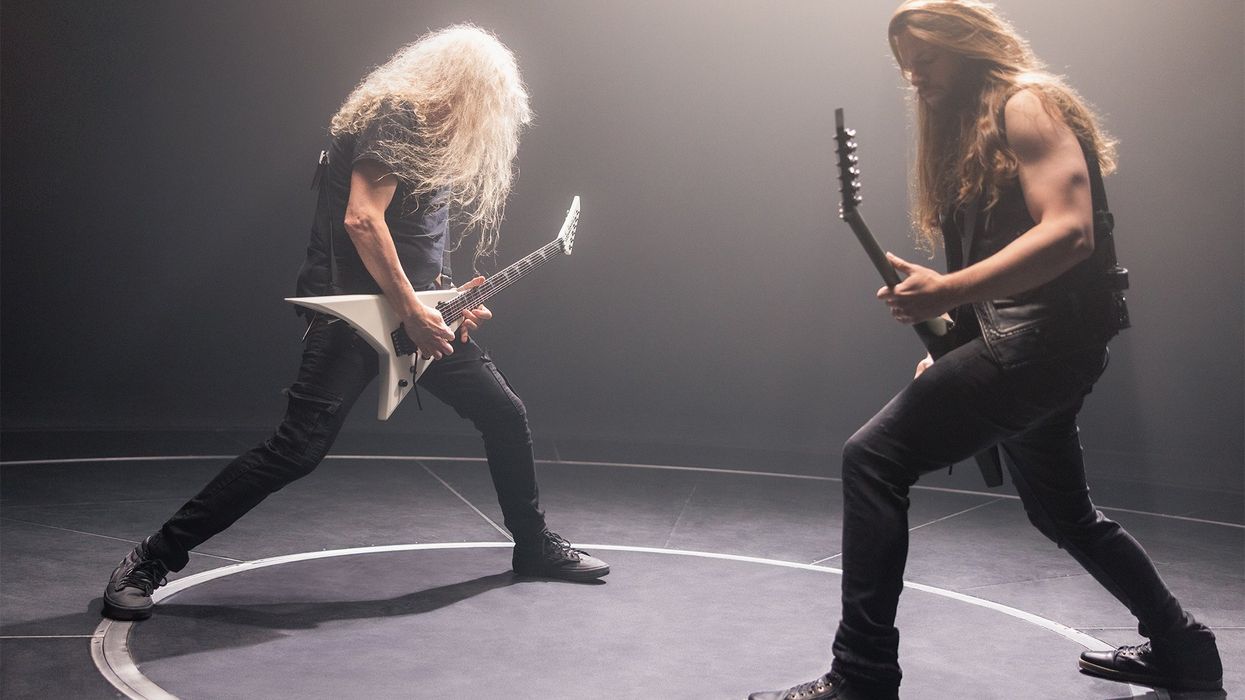
Today, Jackson introduces a legendary shape to its prestigious American Series lineup: The American Series Rhoads RR24 and RR24 HT. Born from a 1980 collaboration between metal icon, Randy Rhoads, and founder, Grover Jackson, this distinctive angular shaped design was built for the ultimate shredding performance. Featuring USA-made Seymour Duncan® JB and ‘59 humbuckers pickups, a reverse 6 in-line headstock and the signature offset Rhoads alder body, the American Series Rhoads delivers the bold, brutal tone that metal enthusiasts demand.
Meticulously crafted in Jackson’s Corona, California factory, the American Series Rhoads is built to devastating perfection through premium materials and components including alder bodies with three-piece neck through construction and 12-16" compound radius ebony fingerboard with jumbo stainless steel frets. This launch expands the American Series beyond its current Soloist™ and Virtuoso™ models, reinforcing Jackson's commitment to supporting heavy music artists with uncompromising quality instruments. Rhoads' pursuit of precise, architectural solos helped define the template for metal guitar playing that continues to influence generations of players. Embodying the authentic Rhoads DNA, this American-made guitar is engineered for shredding perfection.

“The American Series Rhoads was created to bring the legendary shape that metal guitarists have coveted for decades to a new generation,” said Jon Romanowski, VP of Product, Jackson. “Built in the U.S., this premium guitar is engineered for players who demand uncompromising metal tone and performance.”
The American Series Rhoads is available in two models: the RR24 and RR24 HT, with the bridge being the main difference between them. The RR24 HT features a Hipshot hardtail bridge made for rock-solid tuning stability and ease of use for string changes or for drop tunings on the fly. This guitar is available in Satin Black and Snow White. The RR24 takes a different approach with its recessed 1500 Series Floyd Rose® double-locking tremolo system for dive bombs, squeals and flutters while staying in tune through brutal playing. This tremolo-equipped model is available in Satin Black, Matte Army Drab and Snow White.
To introduce the legendary American Rhoads series, Jackson has partnered with metal virtuosos and signature artists, Brandon Ellis and Jeff Loomis. Both Ellis and Loomis continue to leave an indelible mark on the metal genre through their revolutionary playing styles and technical mastery. The Rhoads shape continues to empower guitarists to push the boundaries of heavy music, delivering crushing tone and uncompromising performance. This collaboration reinforces Jackson's commitment to supporting the artists who define modern metal while honoring the legacy of one of guitar's most influential innovators.
“This axe embodies everything the Jackson name has always stood for to me,” said Brandon Ellis. “It's built for metal and speed, and comes 100% tour-worthy right off of the shelf, with bulletproof American construction, high quality specs and hardware and contemporary upgrades. The easily accessible spokewheel adjusted truss rod, push-in style tremolo bar, stainless steel Floyd Rose upgrades, glow in the dark side dots and locking tuners are all huge quality of life improvements for performing musicians like myself. I have the matte finished olive drab version which both feels amazing in my hands and looks killer on anybody who wields this classic, sharp-angled, metal beast of a guitar!”
“The American Series Rhoads is an amazing metal masterpiece!” said Jeff Loomis. “Aggressive looks with killer playability all over the neck, this guitar really stands out. Partnering with Jackson again to showcase this guitar with Brandon Ellis was a total blast and unforgettable experience.”
Watch these legends unleash their metal prowess: Presenting the American Series Rhoads Feat. Jeff Loomis & Brandon Ellis | Jackson Guitars. High-resolution product and lifestyle images of the American Series Rhoads RR24 can be found HERE. Full product descriptions and specifications of the American Series Rhoads RR24 can be found HERE.
AMERICAN SERIES RHOADS RR24
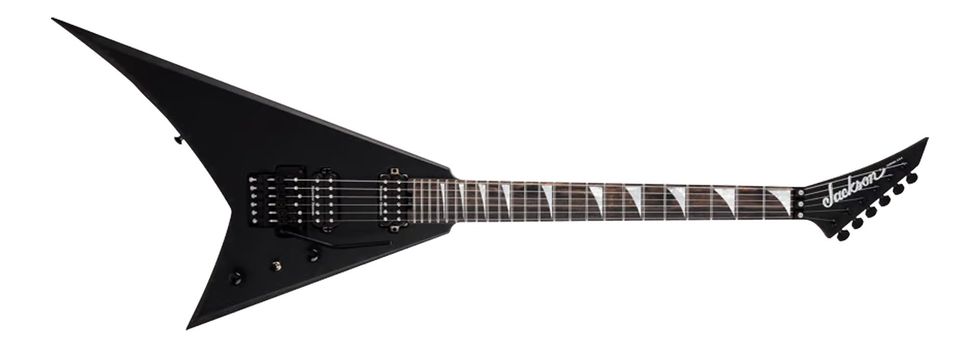
($2,849.99 – $2,899.99 USD, £2,249 GBP, €2,649 EUR, $5,149 – $5,249 AUD, ¥528,000 JPY)
The RR24’s offset Rhoads alder body turns heads with its sleek, weapon-like contours while providing resonant, lively tone. Its neck-through-body three-piece maple neck with graphite reinforcement delivers supreme stability and sustain. 24 Jumbo stainless-steel frets top the 12”-16” compound radius ebony fingerboard allowing effortless bending across the entire fretboard. For tone that’s tight yet expressive, we’ve equipped the RR24 with Seymour Duncan® JB and ‘59 humbuckers. These USA-made pickups roar with thick distortion when you dig in, cleaning up nicely for singing leads. The recessed 1500 Series Floyd Rose® double-locking tremolo system lets you execute dive bombs, squeals and flutters while staying in tune through heavy abuse.
AMERICAN SERIES RHOADS RR24 HT
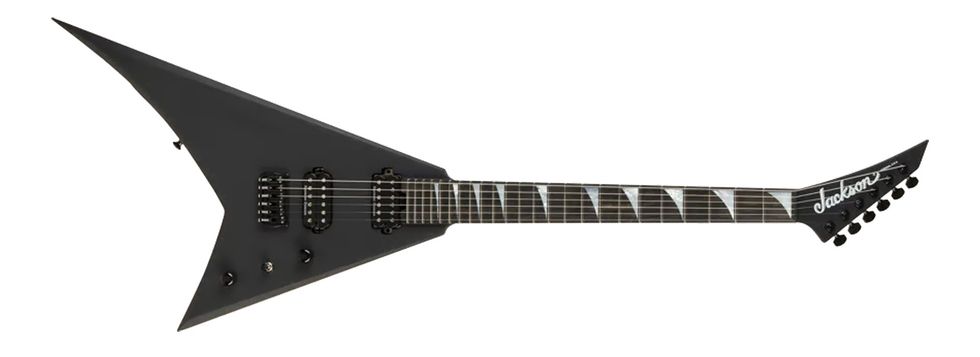
($2,729.99 – $2,779.99 USD, £2,199 GBP, €2,599 EUR, $4,949 – $5,049 AUD, ¥517,000 JPY).
The RR24’s offset Rhoads alder body turns heads with its sleek, weapon-like contours while providing resonant, lively tone. Its neck-through-body three-piece maple neck with graphite reinforcement delivers supreme stability and sustain. 24 Jumbo stainless-steel frets top the 12”-16” compound radius ebony fingerboard allowing effortless bending across the entire fretboard. For tone that’s tight yet expressive, we’ve equipped the RR24 HT with Seymour Duncan® JB and ‘59 humbuckers. These USA-made pickups roar with thick distortion when you dig in, cleaning up nicely for singing leads. The Hipshot® hardtail bridge makes for rock-solid tuning stability, and ease of use for string changes or for drop tunings “on the fly”.
Deftones' Stephen Carpenter Rig Rundown
California metal giants Deftones returned this year with Private Music, their first album in five years. In support of it, they ripped across North America on a string of headline shows and support slots with System of a Down.
We linked with Deftones guitarist Steph Carpenter for a Rig Rundown back in 2013, but a lot has changed since then (and as Carpenter reveals in this new interview, he basically disowns that 2013 rig). Back in August, PG’s Chris Kies caught up with Carpenter again ahead of the band’s gig in Milwaukee, Wisconsin, where the guitarist gave us an all-access walkthrough of his current road rig.
Brought to you by D’Addario
Blue Battle-Axe

This headless, color-shifting Kiesel Vader 8 was the first Kiesel that Carpenter got his hands on.
Kiesel Kavalcade
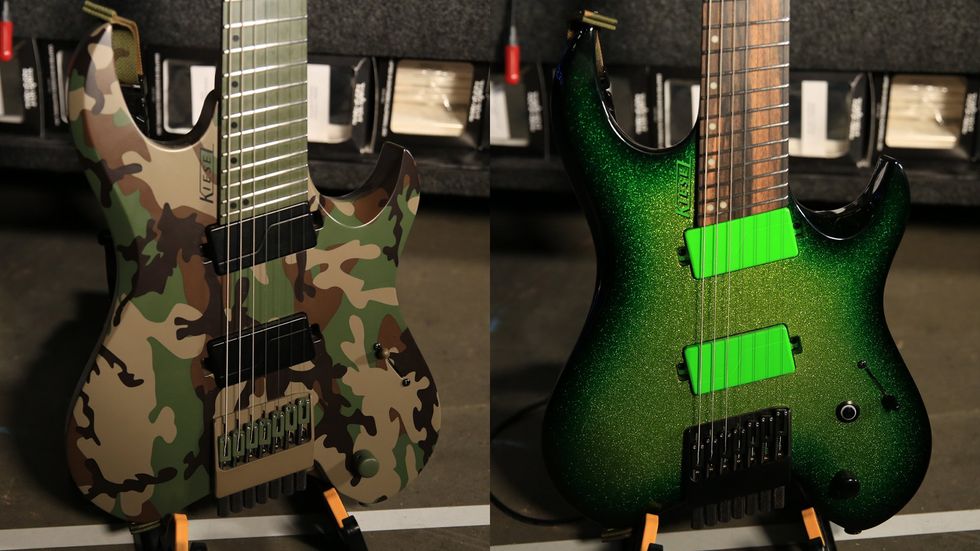
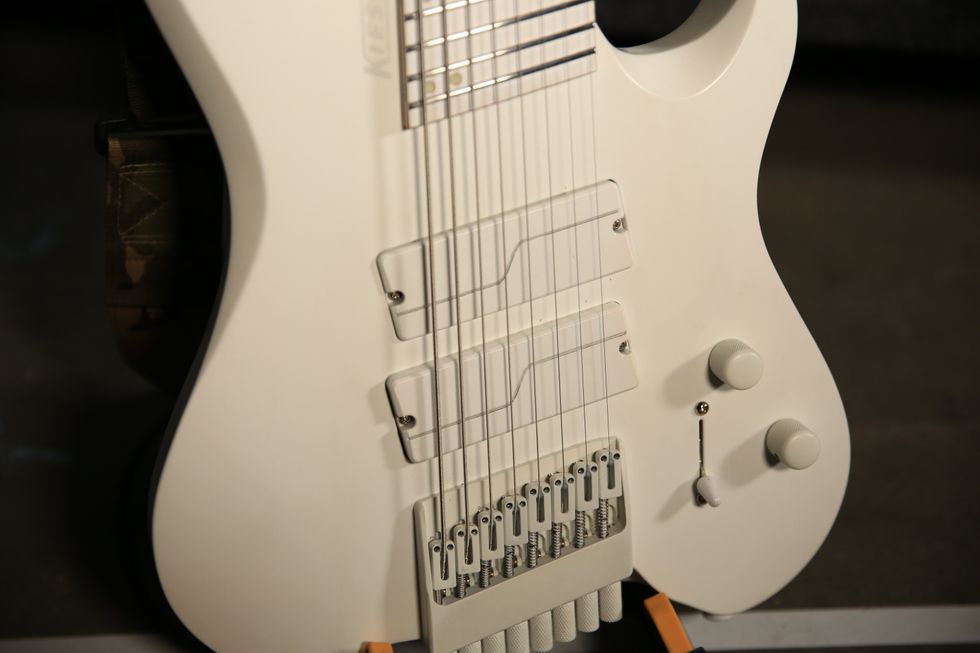
Carpenter requested Vader models in all-black, all-white, and goldtop finishes, then Jeff Kiesel himself surprised Carpenter with the remainder, including the camo and green sparkle models shown here. Carpenter will choose which guitar to use based on how he’s feeling each evening. To record Private Music, he switched between his trusty ESPs and these new favorites.
Steph’s Selections
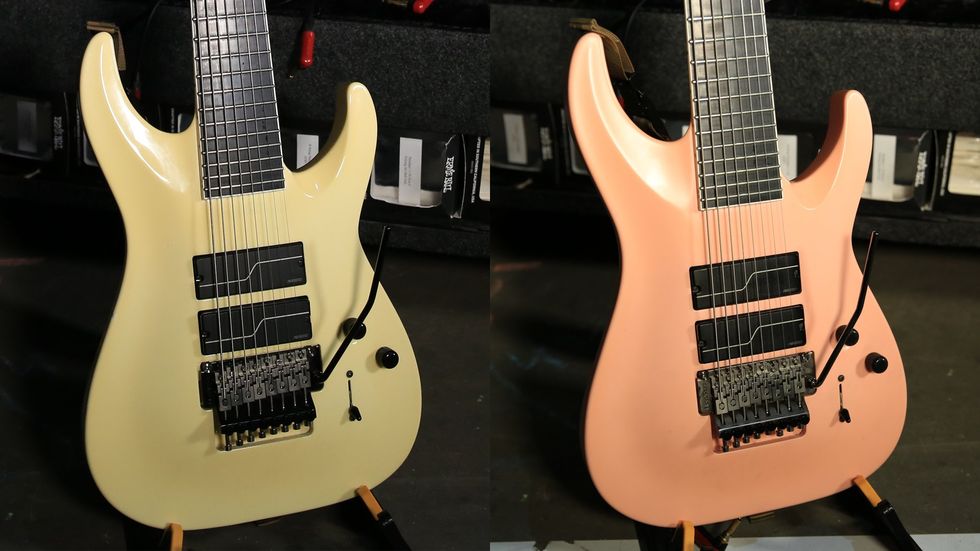
One of Carpenter’s two guitar vaults is full of his current favorite ESPs. Of those, this glow-in-the-dark version, along with the pink-finish model, is his top pick. Curious about his pickup configuration? It’s got nothing to do with sound; it’s purely based on how guitarists like Vivian Campbell and Adrian Vandenberg set up their guitars. Carpenter loved the look, so he copied it.
Back to Bogners
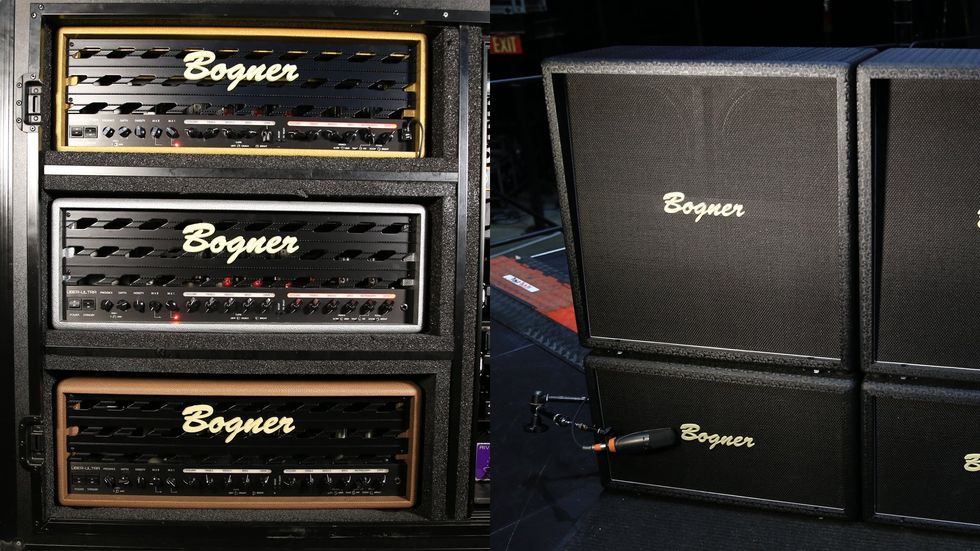
Carpenter says he’s had “too many fails” relying on a completely digital rig, so these days he rolls with a hybrid setup designed by his tech, Greg Dubinovskiy, and Dave Friedman, the latter of whom built the rig.
It’s based around these KT88-loaded Bogner Uberschall Uber-Ultra heads, which are wired to two Bogner 2x12 UberKabs (with one Celestion V-30 and one G12T-75 each) and two Bogner 4x12 UberKabs (with two V-30s and two G12T-75s in an X pattern). A Shure Nexus 57 and Shure KSM32 are used to capture the amp sound.
Rack Rundown
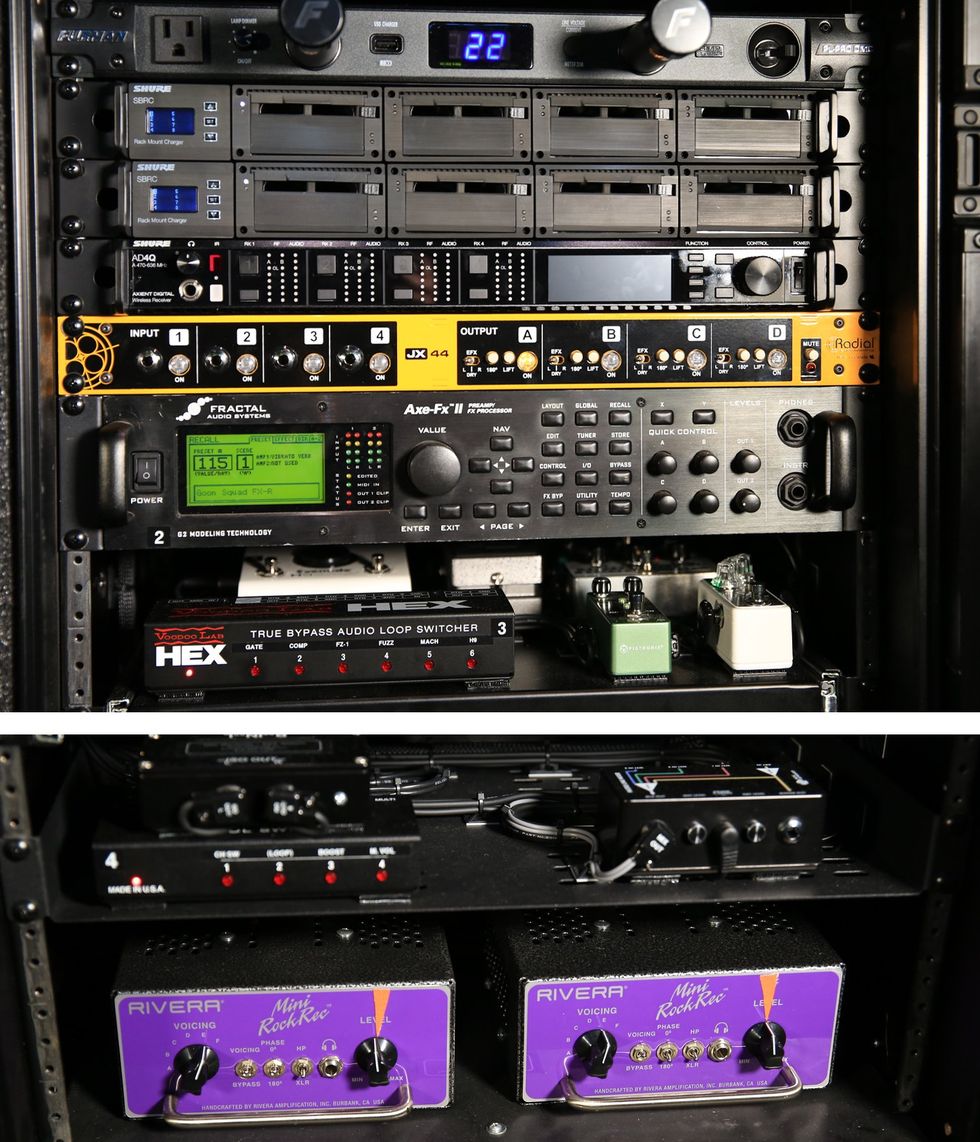
Beside the Bogner’s, another rack houses a Shure AD4Q, Radial JX 44, and a Fractal Axe-Fx II. (Carpenter has no desire to upgrade to the latest model.) Lower down, there’s a pair of Rivera Mini RockRecs.
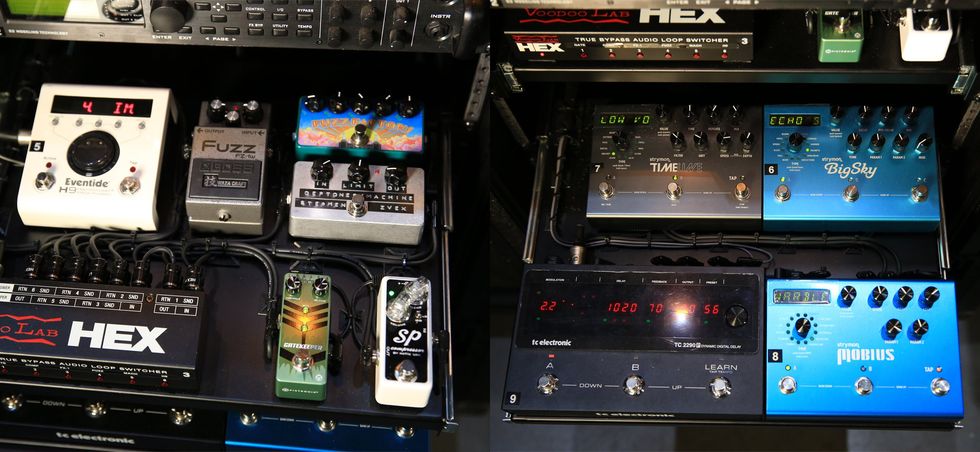
Most of Carpenter’s pedals are shelved below these units, including an Eventide H9, Boss FZ-1, ZVEX Fuzz Factory, custom ZVEX Machine, , Pigtronix Gatekeeper, Xotic SP Compressor, Strymon Mobius, Strymon BigSky, Strymon Timeline, and TC Electronic TC 2290. A Voodoo Lab Hex powers the pedal party.
Steph Carpenter’s Pedalboard
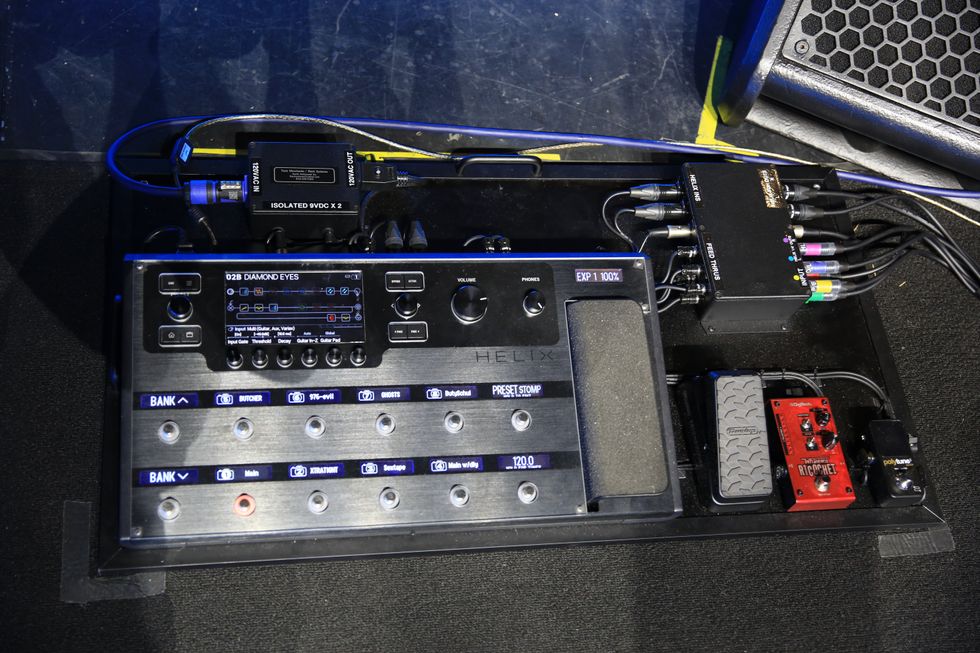
Carpenter’s Line 6 Helix unit is the brain of his setup, and handles all switching. Also on hand are a DigiTech Whammy Ricochet, a Dunlop Volume (X) Mini pedal, and a TC Electronic PolyTune 3 Noir.
Source Audio Launches theEncounter Ambient Delay+Reverb
Source Audio, a leader in next-generation guitar and bass effects pedals, proudly introduces the Encounter Ambient Delay+Reverb, a fully loaded, dual-engine effects pedal designed to unlock immersive, atmospheric soundscapes. Building upon the legacy of Source Audio’s award-winning Collider Delay+Reverb, the Encounter features dual signal processing, allowing users to combine any two of the pedal’s six delay and six reverb effects. Where the Collider focused on classic delay and reverb effects, Encounter ventures into uncharted tonal territory, delivering new, otherworldly effects for guitar, bass, synth, and adventurous sound designers of all kinds.
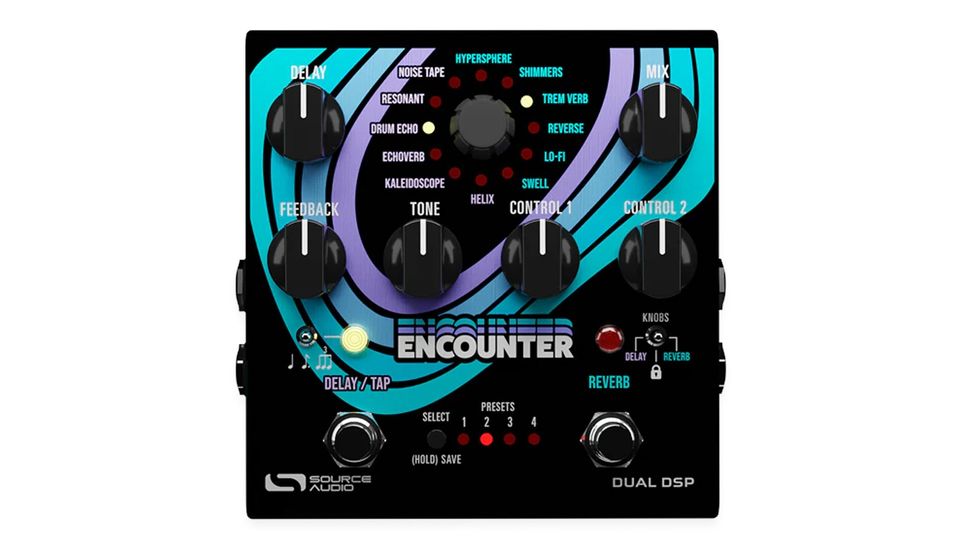
“You asked, so we delivered!” says Roger Smith, President of Source Audio. “Ever since the release of the Collider Delay+Reverb, players have asked us to push further — into more adventurous, exploratory delay and reverb textures. Encounter answers that call. It opens up an expansive new universe of sonic possibility, combining reimagined classics with brand-new algorithms that explore both the familiar and the beautifully unknown.”
At the heart of the Encounter are six delay and six reverb engines that can be used individually or combined in pairs — this includes dual delay and dual reverb setups. Users can route dual effect combinations in series, parallel, or split stereo, with independent footswitch control for each engine, effectively offering the power of two pedals in one easy-to-navigate enclosure. Stereo ins and outs, full MIDI implementation, 8 onboard preset slots (128 presets with MIDI), external expression control, and seamless integration with Source Audio’s free Neuro 3 editing software for iOS, Android, macOS, and Windows further elevate the pedal’s flexibility and creative potential.
The Encounter’s effects collection features brand-new engines such as Hypersphere, a gravity-defying ambient reverb inspired by infinite spatial reflections, Kaleidoscope, a cascading, harp-like delay effect, and Shimmers, a rich, dual-pitched shimmer reverb designed for lush harmonic layering.
Modernized favorites from Source Audio’s acclaimed Ventris Dual Reverb and Nemesis Delay ADT also make a return — Reverse, Lo-Fi, Trem Verb, and Swell reverbs, along with Helix, Drum Echo, Noise Tape (based on the Roland Space Echo) and Resonant delays — all reimagined with expanded parameter control.
In addition, musicians can preview and explore the sounds and editing capabilities of the Encounter before purchasing the pedal, using the Neuro 3’s new SoundCheck™ feature. Neuro 3 is Source Audio's entirely free effects editing, preset sharing, and organizing software. SoundCheck features prerecorded, unaffected guitar, bass, keyboard, and drum loops that can be played through bit-perfect replications of Source Audio One Series pedals. Users can audition presets or use the effect editor and hear changes in real-time, using only a smartphone or computer.
Brickhouse Toneworks Introduces Mason Deluxe P.A.F. Humbuckers
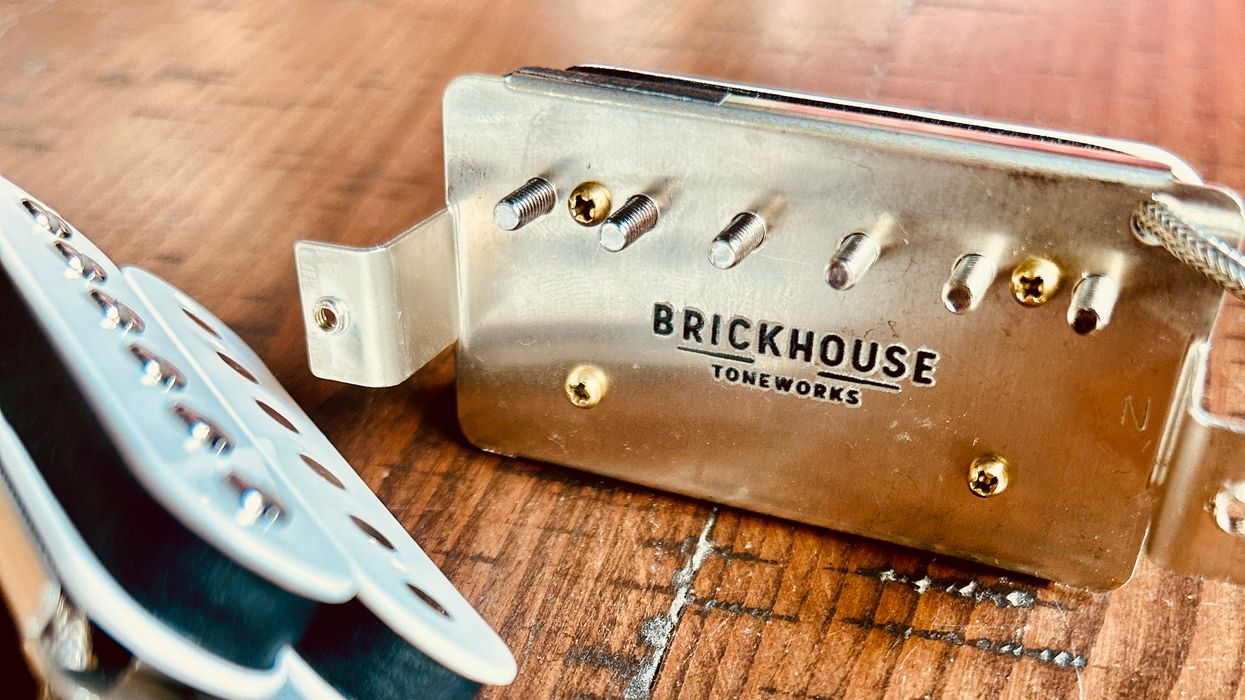
Adding to the company’s lineup of premium US-made pickups, Brickhouse Toneworks has introduced the Mason Deluxe P.A.F. pickup. Available individually or in matched sets, the Mason Deluxe delivers the classic, exquisitely balanced tone of a vintage 1960s P.A.F. humbucker with added bite. They are a direct drop-in replacement for standard sized humbuckers.
Sporting AlNiCo 4 magnets for enhanced attack and articulation, the Mason Deluxe P.A.F. has the clarity of a lower wind with the power of a fuller wind. Pickup master David Shepherd designed the pickup with two slightly different wire thicknesses on each coil, along with carefully calibrated asymmetrical coils, to bring out the maximum frequencies and dynamic range possible.
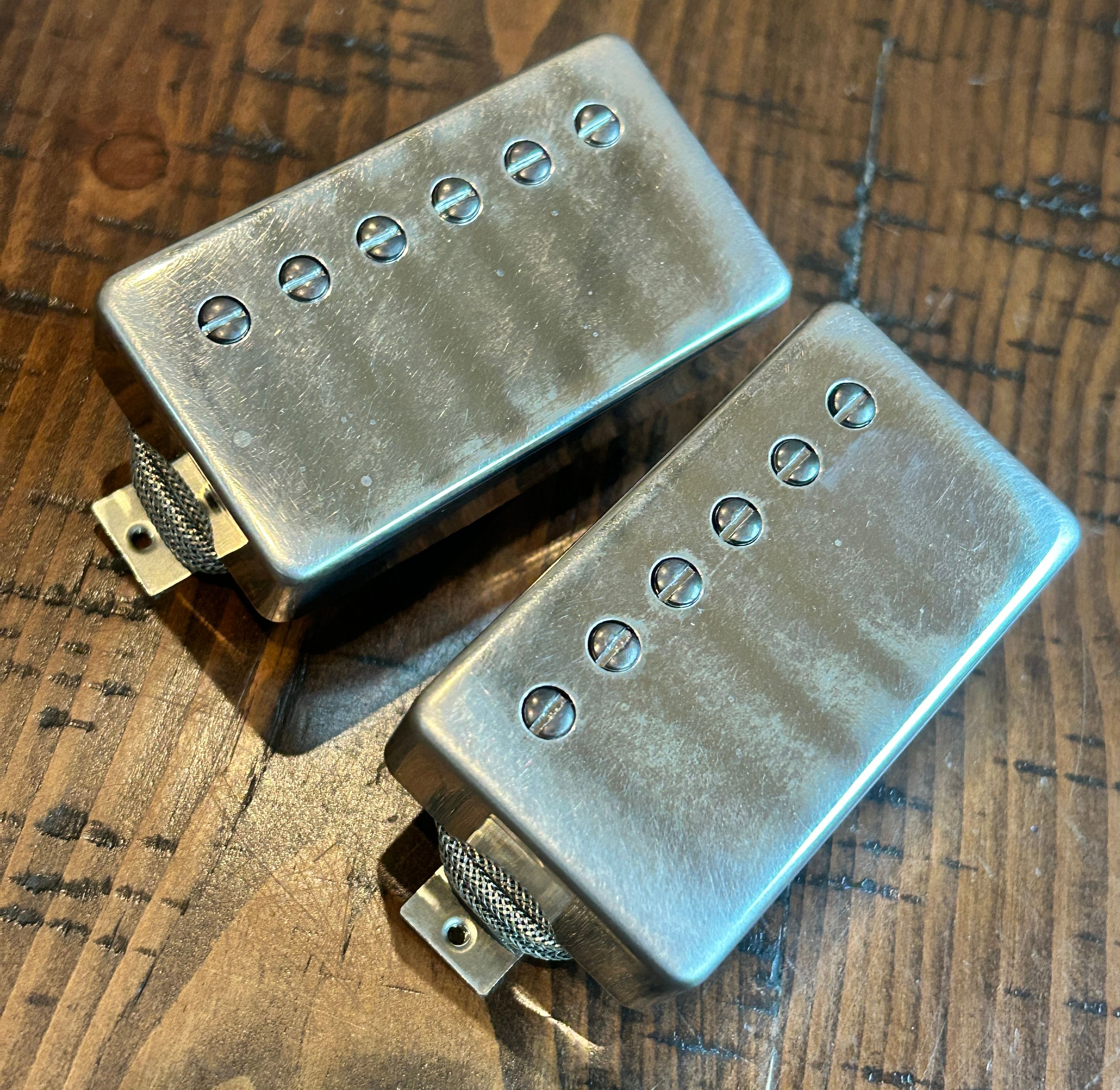
Expanding on the legacy of Brickhouse Toneworks’ highly regarded 1960 P.A.F. and Semi 60 P.A.F. humbuckers, the Mason Deluxe P.A.F.'s deliver a unique tonal profile characterized by a chimey, bell-like clarity and exceptional articulation. The sound is both smooth and responsive, with a dynamic range that allows for a sweet, rolled-off tone as well as a powerful, aggressive distortion. A defining feature is the rich, harmonic overtones that bloom and sustain, providing a heightened sense of depth and dimensionality. The pickups also exhibit a slight microphonic effect, which enhances pick attack definition. This results in a complex, yet clear sound—fat and woody in the neck position, and sparkling with pronounced punch and tonal definition in the bridge.
The result: an extraordinarily responsive P.A.F. humbucker with a transparent and open sound, allowing the guitar and player's natural tone to be the star of the show.
Key Features of the Mason Deluxe:
- AlNiCo 4 Roughcast Long Bar Magnets, Unpotted Coils
- Vintage Correct Long Leg Frames and Butyrate Plastic Bobbins
- Vintage Correct Alloys, Coil Wire and Braided Single Conductor Leads
- Vintage Correct Hand Ground, Hand Buffed P.A.F. Covers
- DC Resistance - Bridge: 8.1k (Average)
- DC Resistance - Neck: 7k (Average)
- Made in the USA with premium quality materials
The Brickhouse Toneworks Mason Deluxe P.A.F. street price starts at $195 each and starts at $390 per set. Visit www.brickhousetone.com or contact info@brickhousetone.com for more information and order yours directly.
$1,299 Tube Amp That Does It ALL?! | Bad Cat Ocelot Amp Demo
Mad Cat!—The 2 X EL84, 20-watt Ocelot can breathe fire when it’s not sounding silky smooth. The Ocelot brings together the warmth of pure analog tube circuitry with advanced digital features, redefining what’s possible in a small-format amp. Whether you're recording at home, gigging, or practicing silently with headphones, the Ocelot adapts to your environment without ever compromising your tone.
Channel 1 features sparkling, high-headroom cleans with the ability to nudge into rich edge-of-breakup tones via a Hi/Lo mode switch. Channel 2 brings tight, punchy crunch and full-bodied, high-gain saturation—with articulate response and massive sustain.
Each channel has its own volume control, and the amp includes shared Treble, Mid, Bass, and Presence EQ for easy tone shaping.
Two Notes Torpedo DynIR integration with six onboard virtual cabinet presets from the official Bad Cat DynIR Pack. Selectable Power Modes – Choose between 20W for full punch or 1W for quiet playing. XLR and Headphone Outs – For silent practice or direct-to-DAW recording, complete with Cab Sim and adjustable Cab Level control. Buffered Effects Loop – Keep your pedals sounding pristine and punchy. USB-C Port – For firmware updates and remote editing via Two notes Torpedo Remote software. MIDI Control – Full MIDI implementation for switching channels, modes, and cab presets on the fly. And thanks to its internal speaker load, you can use the Ocelot without an external cabinet—perfect for late-night jams or tracking in a silent setup.
EBS updates NeoLine 112 Cabinet with deeper dimensions and improved sound
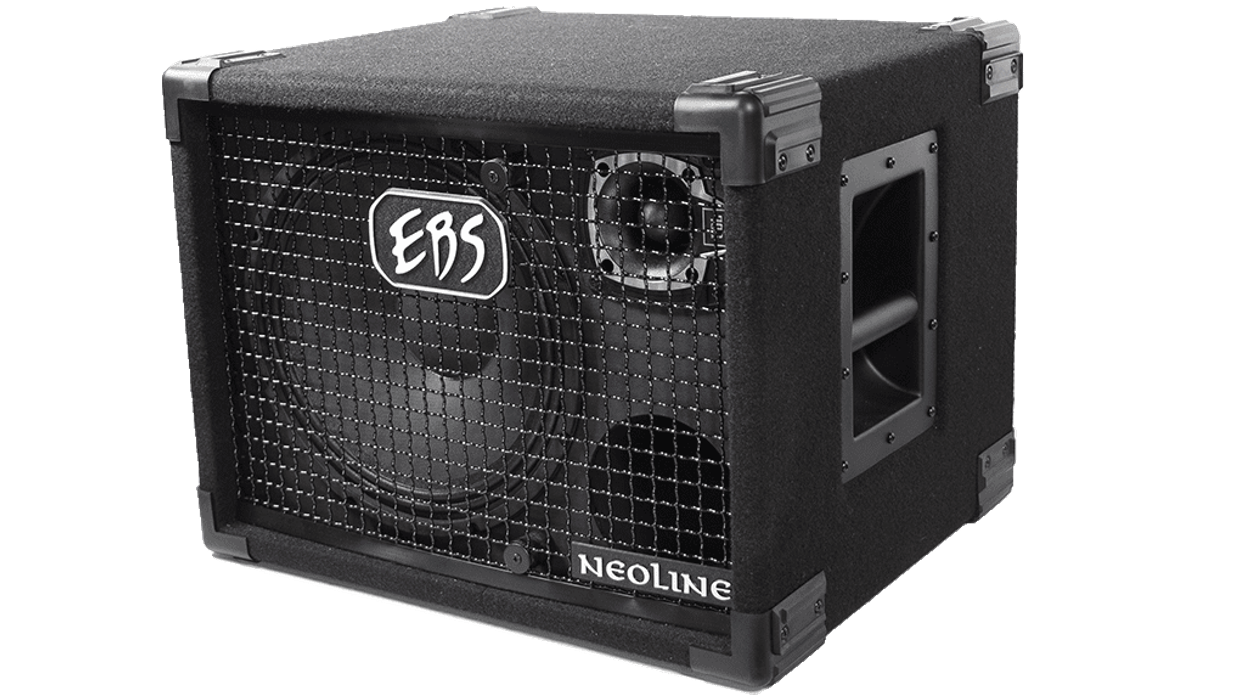
EBS is proud to unveil the newly enhanced NeoLine 112 Mk2 bass cabinet, now shipping with key upgrades that bring even more power, low-end, and reliability to the stage.
The first significant change: the cabinet is now 4 inches deeper, offering a noticeable improvement in low-end response, projection, and overall tonal richness. This enhancement ensures that today's bassists get the punch and presence they need from a compact cabinet, whether they're in the studio, on tour, or pushing the limits live.
Second, EBS has swapped out the previous flip handles in favor of a single heavy-duty deep-dish handle. This small but significant upgrade helps eliminate the risk of rattling noise, making the cab perform securely even at high volumes, while also improving durability and ease of transport.
Third, the high-performance tweeter is now isolated and sealed from the rest of the cabinet, which also helps to reduce the risk of noise due to the sound pressure within the cabinet.Despite the deeper cabinet, and due to the Neodymium speakers and choice of wood, it remains a lightweight cabinet, weighing in at 14.35 kg (31.6 lb).
Already a favorite for its lightweight construction and road-ready build, the updated NeoLine 112 (Mk2) now delivers even greater performance with no compromises. It's a compact speaker for serious players. Despite the improvements, the price remains intact.
The updated NeoLine 112 Mk2 is available now.
Find out more at https://ebssweden.com/cabs/neoline/
Fender Introduces LE Vintera II Road Worn
Today, Fender is expanding its acclaimed Vintera® II series with a Limited Edition Road Worn® lineup, era-correct classics from the ‘50s and ‘60s pair vintage-inspired designs and modern upgrades with the lived-in look of a well-loved instrument. Each model features a new subtle aging process—light checking, gentle wear patterns, and a semi-gloss finish—delivering unmistakable vintage feel and unmatched sound of a classic Fender®.
Limited Edition Vintera® II Road Worn® ‘60s Stratocaster®
($1,599.99 USD, £1,349 GBP, €1,599 EUR, $2,649 AUD, ¥269,500 JPY)
Featuring a variety of vintage colors finished in Road Worn® aged nitrocellulose lacquer, the Vintera® II Road Worn® ‘60s Stratocaster® recreates the look and feel of a well-played classic. The limited Road Worn models are enhanced with a new subtle aging process combining light checking, gentle wear patterns and a semi-gloss finish, while maintaining the authentic broken-in feel players love about vintage Fenders. The ‘60s “C”-shape maple neck with 7.25” radius rosewood fingerboard and vintage-tall frets provides supreme comfort and outstanding feel. Under the hood, you’ll find a trio of vintage-style ‘60s pickups that deliver all the warm, sparkling tones that made Fender® famous. Other features include a synchronized tremolo with bent steel saddles for expressive vibrato and vintage-style tuning machines for enhanced tuning stability. Options include Rosewood Fingerboard in Sonic Blue and Maple Fingerboard in Black.

Fender Vintera II Road Worn '60s Stratocaster Maple Fingerboard Electric Guitar
Limited Edition Vintera® II Road Worn® ‘60s Telecaster®
($1,599.99 USD, £1,349 GBP, €1,599 EUR, $2,649 AUD, ¥269,500 JPY)
Featuring a variety of vintage colors finished in Road Worn® aged nitrocellulose lacquer, the Vintera® II Road Worn® ‘60s Telecaster® recreates the look and feel of a well-played classic. The limited Road Worn models are enhanced with a new subtle aging process combining light checking, gentle wear patterns and a semi-gloss finish, while maintaining the authentic broken-in feel players love about vintage Fenders. The ‘60s “C”-shape maple neck with 7.25” radius rosewood fingerboard and vintage-tall frets provides supreme comfort and outstanding feel. Under the hood, you’ll find a pair of vintage-style ‘60s pickups that deliver all the crystal-clear chime and raw, steely twang that made Fender® famous. Other features include a vintage-style 3-saddle bridge with slotted steel saddles and vintage-style tuning machines for enhanced tuning stability. Options include Rosewood Fingerboard in Burgundy Mist Metallic and Maple Fingerboard in Blonde.

Fender Vintera II Road Worn '60s Telecaster Rosewood Fingerboard Electric Guitar
Limited Edition Vintera® II Road Worn® ‘50s Jazzmaster®
($1,699.99 USD, £1,399 GBP, €1,649 EUR, $2,799 AUD, ¥275,000 JPY)
Featuring a variety of vintage colors finished in Road Worn® aged nitrocellulose lacquer, the Vintera® II Road Worn® ‘50s Jazzmaster® recreates the look and feel of a well-played classic. The limited Road Worn models are enhanced with a new subtle aging process combining light checking, gentle wear patterns and a semi-gloss finish, while maintaining the authentic broken-in feel players love about vintage Fenders. The ‘50s “C”-shape maple neck with 7.25” radius rosewood fingerboard and vintage-tall frets provides supreme comfort and outstanding feel. Under the hood, you’ll find a pair of vintage-style ‘50s single-coil pickups that deliver all the sweet and sparkling, warm and woody tone that made Fender® famous. Other features include a vintage-style floating tremolo for expressive vibrato and vintage-style tuning machines for enhanced tuning stability. Options include Rosewood Fingerboard in 3-Color Sunburst and Rosewood Fingerboard in Fiesta Red.

Limited Edition Vintera® II Road Worn® ‘60s Precision Bass®
($1,599.99 USD, £1,399 GBP, €1,649 EUR, $2,649 AUD, ¥269,500 JPY)
Featuring a variety of vintage colors finished in Road Worn® aged nitrocellulose lacquer, the Vintera® II Road Worn® ‘60s Precision Bass® recreates the look and feel of a well-played classic. The limited Road Worn models are enhanced with a new subtle aging process combining light checking, gentle wear patterns and a semi-gloss finish, while maintaining the authentic broken-in feel players love about vintage Fenders. The ‘60s “C”-shape maple neck with 7.25” radius rosewood fingerboard and vintage-tall frets provides supreme comfort and outstanding feel. Under the hood, you’ll find a vintage-style ‘60s split-coil Precision pickup that delivers all the warm, dynamic and powerful tone that made Fender® famous. The vintage-style 4-saddle bridge and vintage-style tuning machines provide classic looks with enhanced intonation and tuning stability to complete the package. Options include Rosewood Fingerboard in Fiesta Red and Charcoal Frost Metallic.

Gibson Custom Introduces Five New Murphy Lab Light Aged Acoustics
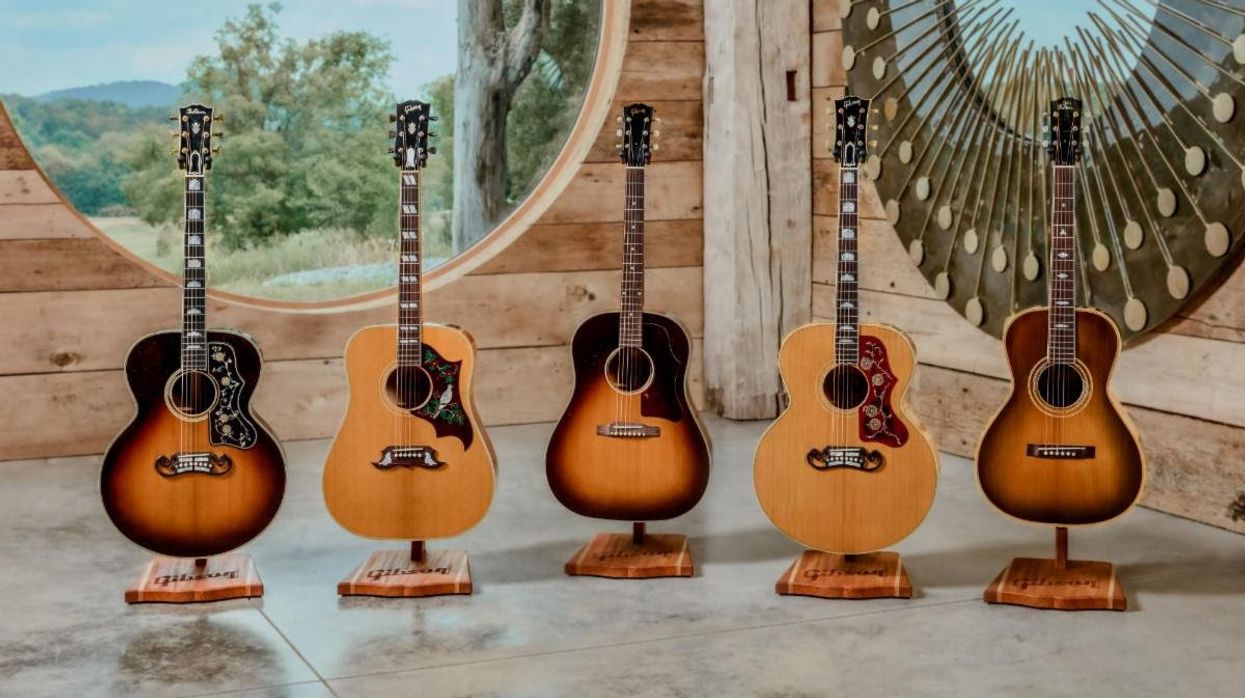
Gibson is proud to introduce five new acoustic reissues for the Gibson Custom Murphy Lab Light Aged acoustic collection, delivering well-worn favorites, built brand new, with the look, tone, and played-in feel of cherished vintage originals.
Each one of the five new additions to the Gibson Custom Murphy Lab Light Aged acoustic collection is a masterfully crafted reproduction of a cherished Gibson acoustic guitar model from Gibson’s first Golden Era. The Murphy Lab Light Aged acoustic lineup from Gibson Custom all feature either red spruce or Sitka spruce tops that have been thermally aged to give them the sound of a well-seasoned vintage guitar. The new additions to our Murphy Lab Light Aged lineup of vintage acoustic reissue models feature light lacquer checking, light dings, pick trails, and rounded fretboard edges, giving them the tone, look, and played-in feel of cherished vintage originals. Gibson Custom Murphy Lab Light Aged acoustic guitars are well-worn favorites, built brand new.
Explore the full Gibson Custom Murphy Lab Light Aged acoustic collection, now available worldwide on Gibson.com HERE.
Each acoustic guitar in the Murphy Lab Light Aged collection comes with an era-correct hardshell guitar case that corresponds with the style of case that was in use when that model was released, adding to the vintage ownership experience.
1929 Nick Lucas Special Light Aged
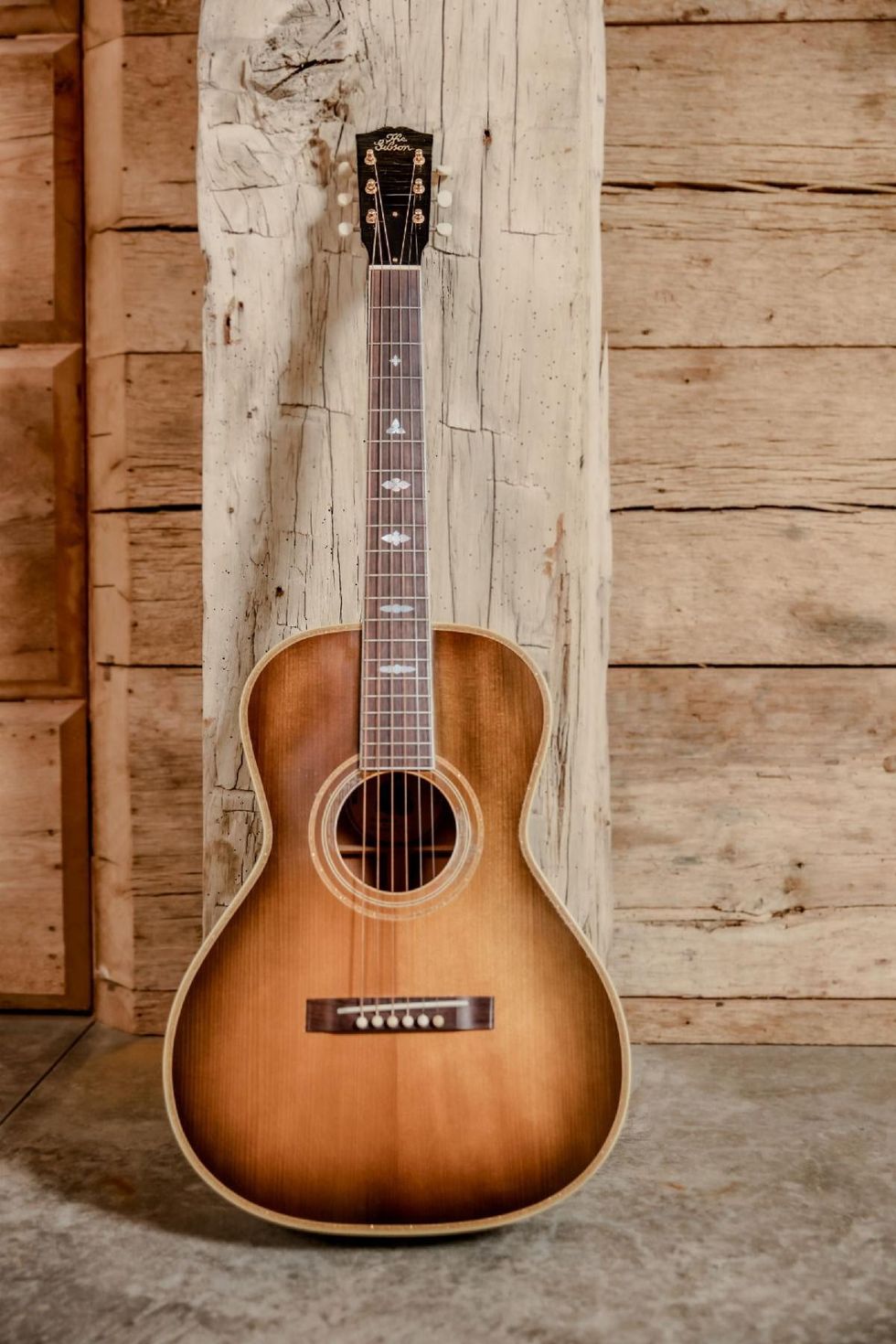
A small-bodied legend with a big voice
Nick Lucas, known as “The Crooning Troubadour,” was a pioneering entertainer of the 1920s—one of the first to record guitar solos and perform with a guitar on the radio. His influence helped elevate the guitar as both a solo and accompaniment instrument. In 1926, Gibson honored Lucas’s request for a custom design, resulting in the Nick Lucas Special—the company’s first artist signature model, featuring a deeper body for enhanced bass response and tonal richness.
Now, Gibson Custom proudly introduces the 1929 Nick Lucas Special Light Aged, a stunning recreation of this historic model. Built with a deeper mahogany body shaped like the L-00, it features a thermally aged red spruce top, gold sparkle multi-ply binding, and a matching L-2 style rosette. The mahogany neck joins the body at the 12th fret and has a C-shaped profile. The bound rosewood fretboard is equipped with 20 frets and is adorned with mother-of-pearl Nick Lucas inlays with engraved details. Gold Waverly tuners with ivoroid oval buttons are installed on the headstock, which also features a vintage-style “The Gibson” logo in mother-of-pearl. Finished in Argentine Grey with Murphy Lab Light Aging, it captures the look and feel of a well-loved original. Housed in a Red Line-style case, this model delivers timeless tone and unmatched character.
1963 Dove Light Aged:
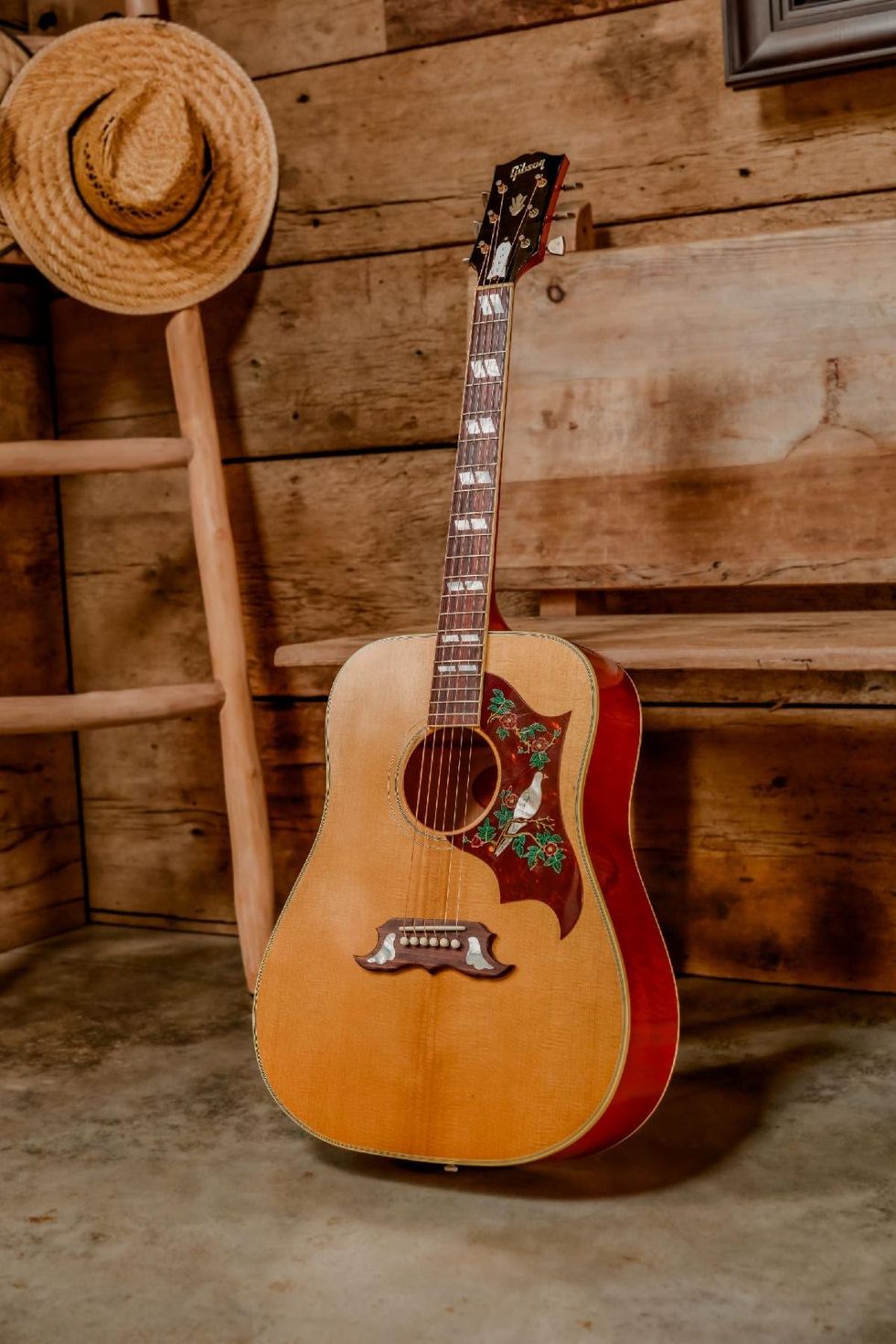
All the tone, charm, and character of a vintage Dove—reborn
First introduced in 1962, the Gibson Dove™ quickly became an icon of the square-shoulder acoustic family, following the Hummingbird™. With its bold voice and distinctive look, the Dove has been favored by legends like Elvis, Tom Petty, and Alex Lifeson. Now, Gibson Custom proudly presents the 1963 Dove Light Aged—a meticulous recreation of the early Dove models, crafted to deliver vintage tone and feel in a brand-new instrument.
Featuring a thermally aged Sitka spruce top with traditional scalloped X-bracing and beautifully flamed maple back and sides in a Cherry finish, this Dove sings with clarity and power. The mahogany neck has a comfortable Round profile, paired with an Indian rosewood fretboard adorned with mother-of-pearl parallelogram inlays. A longer 25.5” scale length and maple body give it a bright, full voice that stands apart from the Hummingbird.
Details like the rosewood Dove bridge with inlaid doves, engraved pickguard, and Kluson® Waffleback tuners complete the vintage aesthetic. Lightly aged by the Murphy Lab, it offers the look and feel of a well-loved original and comes housed in a vintage-style black hardshell case for the full Gibson Custom experience.
1955 J-45 Light Aged:
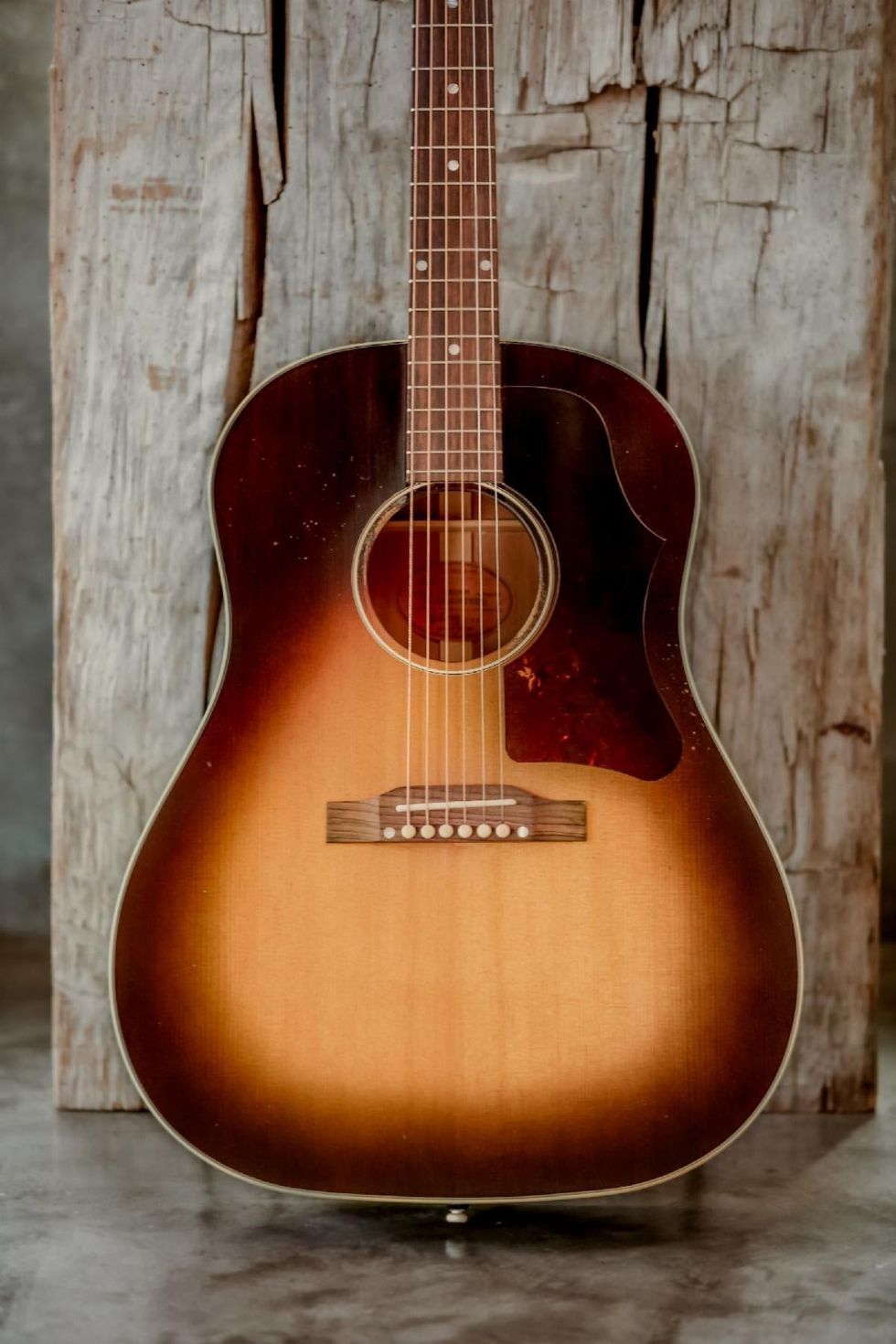
A faithful tribute to the mid-50s Workhorse
First introduced in 1942, the Gibson J-45™ quickly earned its nickname, “The Workhorse,” for its straightforward design, warm tone, and unmatched versatility. By 1955, key updates—like a longer fretboard with 20 frets and a larger pickguard—helped define the model’s enduring legacy. Today, it remains one of the most recorded and best-selling acoustic guitars of all time.
The 1955 J-45 Light Aged from Gibson Custom is a masterfully handcrafted recreation of this pivotal model, built in Bozeman, Montana. It features a round-shoulder mahogany body with a thermally aged Sitka spruce top and traditional X-bracing installed with hide glue for vintage tone and resonance. The mahogany neck has a comfortable Round profile and is joined with a compound dovetail neck joint. A rosewood fretboard with mother-of-pearl dot inlays, bone nut and saddle, and vintage-style Grover® strap tuners complete the classic look.
Finished with Murphy Lab’s Light Aging treatment and lightly aged hardware, it captures the feel of a well-played original. Packaged in a 1950s-style Lifton™ hardshell case, the 1955 J-45 Light Aged delivers the authentic tone, vibe, and craftsmanship of Gibson’s Golden Era.
Pre-War SJ-200 Rosewood Light Aged:
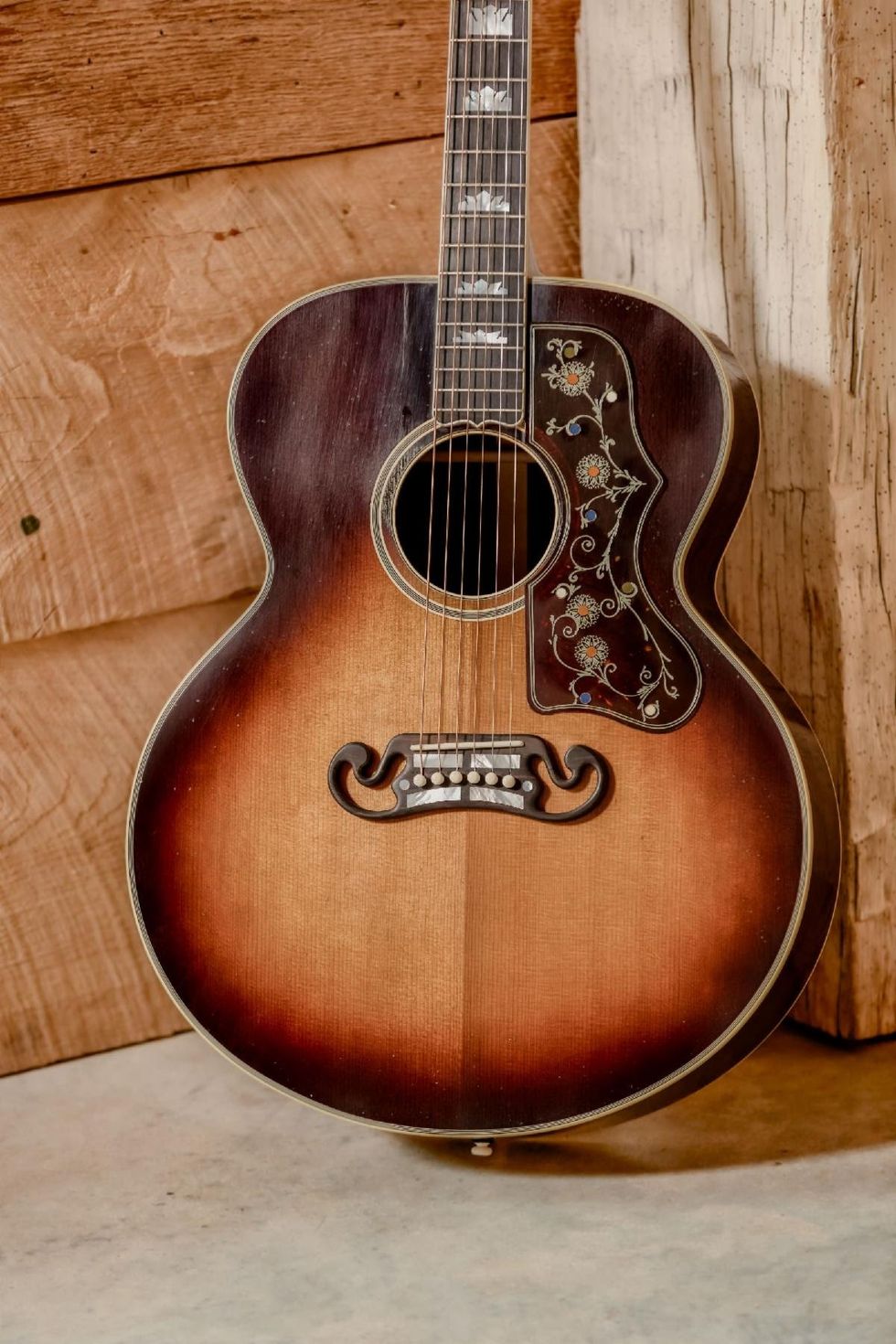
All the vibe, feel, and vintage allure of the rare rosewood Pre-War Super Jumbo
Originally introduced in 1937, the Gibson SJ-200™ quickly earned its title as “the King of the Flat-Tops” thanks to its bold sound, impressive projection, and commanding presence. Early models featured rosewood back and sides, but due to limited demand during the post-Depression era, production numbers remained low—making these early rosewood-bodied SJ-200s highly sought-after by collectors today. Gibson Custom now proudly presents the Pre-War SJ-200 Rosewood Light Aged, a meticulous recreation of those rare originals. It features a thermally aged red spruce top with traditional scalloped X-bracing, rosewood back and sides with a three-rope marquetry strip, and ornate multi-ply binding throughout. The AAA maple neck includes a walnut stringer and stinger detail, while the ebony fretboard and bridge are adorned with mother-of-pearl inlays. Gold Grover® Imperial™ tuners and a tortoise pickguard with multi-colored dots complete the look.
Finished with Murphy Lab’s Light Aging treatment and housed in a period-correct Red Line case, this model captures the spirit and craftsmanship of Gibson’s Golden Era—delivering vintage tone, feel, and aesthetic in a stunning modern build.
1957 SJ-200 Light Aged:
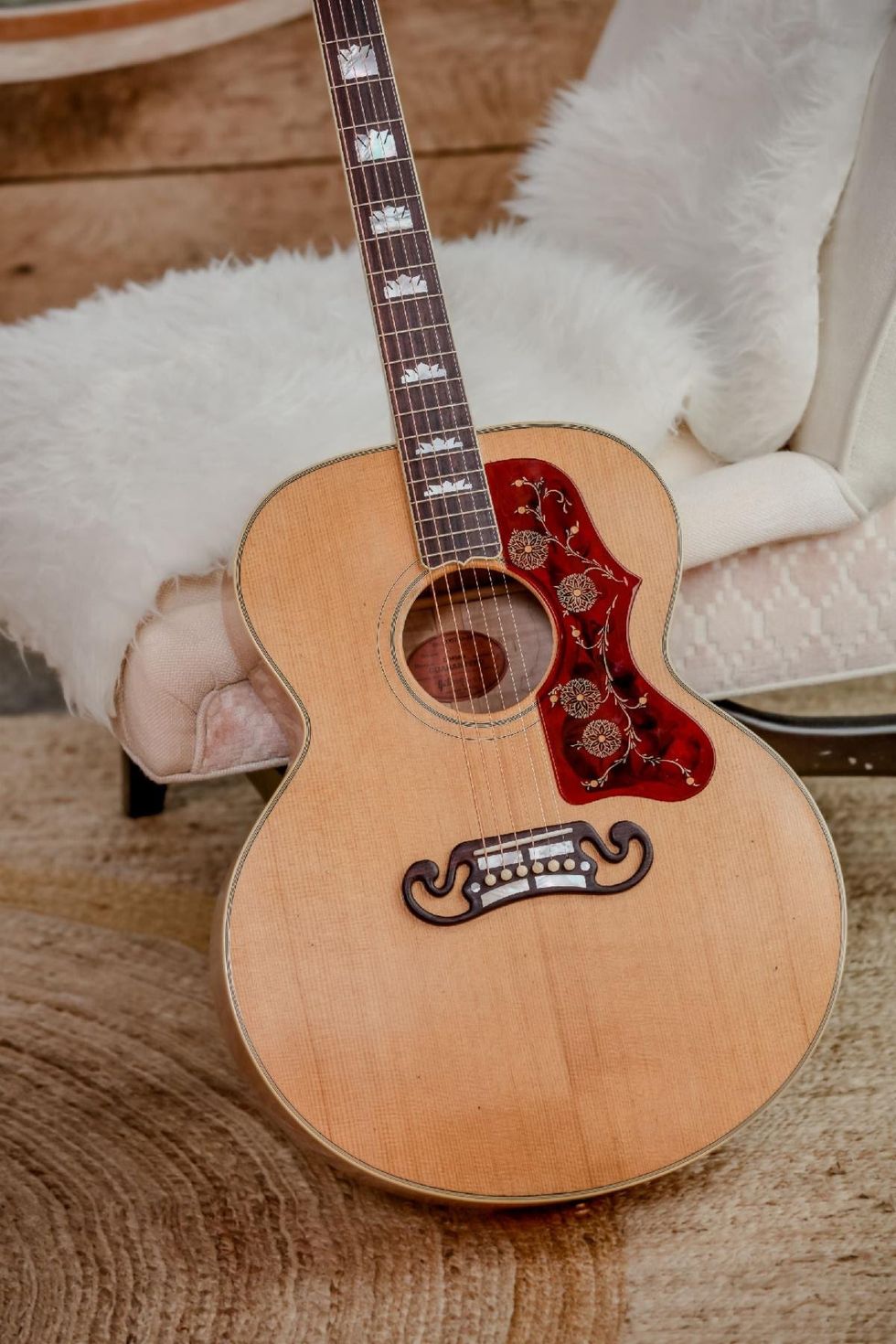
All the vibe, feel, and vintage allure of the iconic 1950s Super Jumbo
Introduced in 1937, the Gibson SJ-200 earned its reputation as “the King of the Flat-Tops” for its bold tone, powerful projection, and striking presence. By 1947, maple replaced rosewood for the back and sides, and the SJ-200 became a favorite among legends across genres—from Hollywood cowboys to rock royalty. Today, vintage 1950s models are prized by collectors.
Gibson Custom now presents the 1957 SJ-200 Light Aged, a faithful recreation of this celebrated era. It features a thermally aged Sitka spruce top with scalloped X-bracing installed using hide glue, AAA flamed maple back and sides with a checkerboard marquetry strip, and ornate multi-ply binding. The AAA maple neck includes a walnut stringer and stinger detail, while the rosewood fretboard and Moustache™ bridge are adorned with mother-of-pearl inlays. Gold Gotoh® tuners and a classic tortoise pickguard complete the vintage aesthetic.
Finished with Murphy Lab’s Light Aging treatment and paired with lightly aged hardware, this model captures the look and feel of a well-played original. It comes housed in a period-correct 1950s-style Lifton™ case, delivering an authentic vintage experience only Gibson Custom can offer.
Alex Skolnick Trio Announces New Album 'Prove You’re Not A Robot'

Brooklyn-based jazz-rock innovators Alex Skolnick Trio (AST) return this fall with PROVE YOU’RE NOT A ROBOT, the group’s sixth LP, arriving November 7, 2025. The album’s first single, a wildly inventive take on Tom Petty’s “Breakdown,” is available today. Listen here.
Blending fearless improvisation, genre-defying arrangements, and the virtuosity of its members, PROVE YOU’RE NOT A ROBOT captures AST at the height of their creative powers. The title reflects both a wry nod to our tech-saturated era and a deeper meditation on humanity, direct interaction, and the irreplaceable spark of live musicianship in an age of artificial intelligence.
Recorded with a range of vintage and custom instruments — from a Roger Sadowsky archtop to a 1935 Gibson L-00 acoustic — the album spans moods from the uplifting “Guiding Ethos” to the mind-bending Chick Corea/Steve Howe mashup “Armando’s Mood.” Alongside Skolnick’s inventive guitar work, bassist Nathan Peck and drummer Matt Zebroski bring rhythmic complexity and emotional depth, with odd-time signatures and genre twists that have become AST hallmarks.
“I feel this album represents my strongest work as a composer,” says Skolnick. “Nathan and Matt really brought their A-game throughout. I think it’s safe to say this is the record we’re all most proud of.”
Since forming in the early 2000s, AST has reimagined the jazz guitar trio, melding influences as far-reaching as Wes Montgomery, Black Sabbath, Prince, tango, calypso, and Western swing. Known for their adventurous covers of rock and metal classics, they’ve earned praise from outlets like Billboard, Downbeat, Jazziz, The Village Voice, and NPR, and have toured internationally, captivating audiences from Norway’s Larvik Guitar Festival to Paris’s The Olympia and New York’s Radio City Music Hall.
PROVE YOU’RE NOT A ROBOT promises to be a bold addition to the AST legacy — as engaging for jazz aficionados as it is for rock fans curious about the inventive, genre-bending journey of Testament original guitarist Alex Skolnick.
Album Release Date: November 7, 2025
First Single “Breakdown” Release Date: September 12, 2025
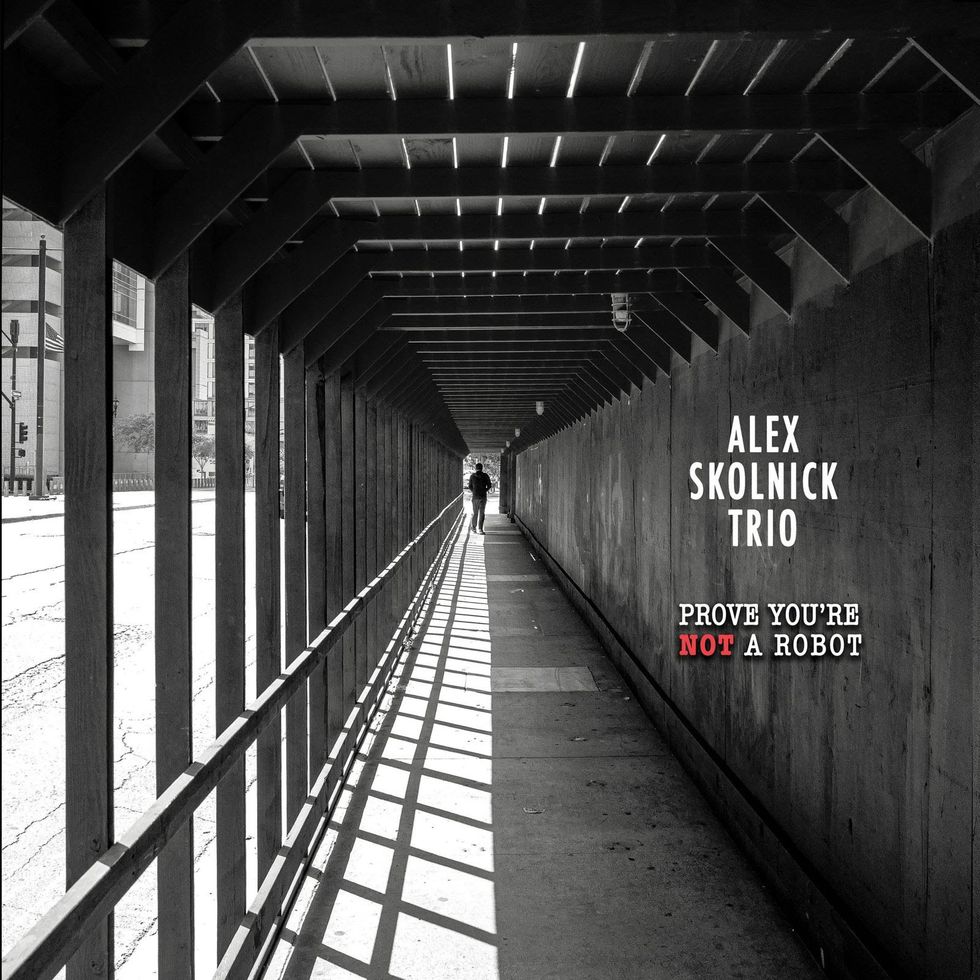
PROVE YOU’RE NOT A ROBOT Tracklist
- Parallel Universe
- Armondo’s Mood
- Infinite Hotel
- Prove You’re Not A Robot
- Guiding Ethos
- Breakdown
- The Polish Goodbye
- Asking For A Friend
AST on Tour
September 30 - New York, NY, The Cutting Room (Album launch party)
November 15 - Montreal, QB, Piranha Bar
November 16 – Ottawa, ON, Brass Monkey
November 17 – Pittsburgh, PA. City Winery
November 19 – Detroit, MI, Token Lounge
November 20 – Chicago, IL. Reggie’s
November 21 – Cleveland, OH, Irishtown Bend Tap Room
November 22 – Buffalo, NY, Nietzsche’s
November 23 – Anniville, PA, The Allen Theatre
2026
January 8 – The Woodlands, TX, Dosey Doe
January 9 – McKinney, TX, Guitar Sanctuary
January 11 – San Antonio, TX, Fitzgerald’s
January 13 – Los Angeles, CA, Baked Potato
January 14 – Sacramento, CA, Harlow’s
January 15 – Seattle, WA, Funhouse
January 16 – Portland, OR, Jack London Revue
January 17 – Redding, CA, The Dip
January 18 – Mill Valley, CA, Sweetwater Music Hall
Alex Skolnick Trio is:
Alex Skolnick – Guitar
Matt Zebroski – DrumsNathan Peck - Bass
D’Addario Launches Players Choice Custom String Shop
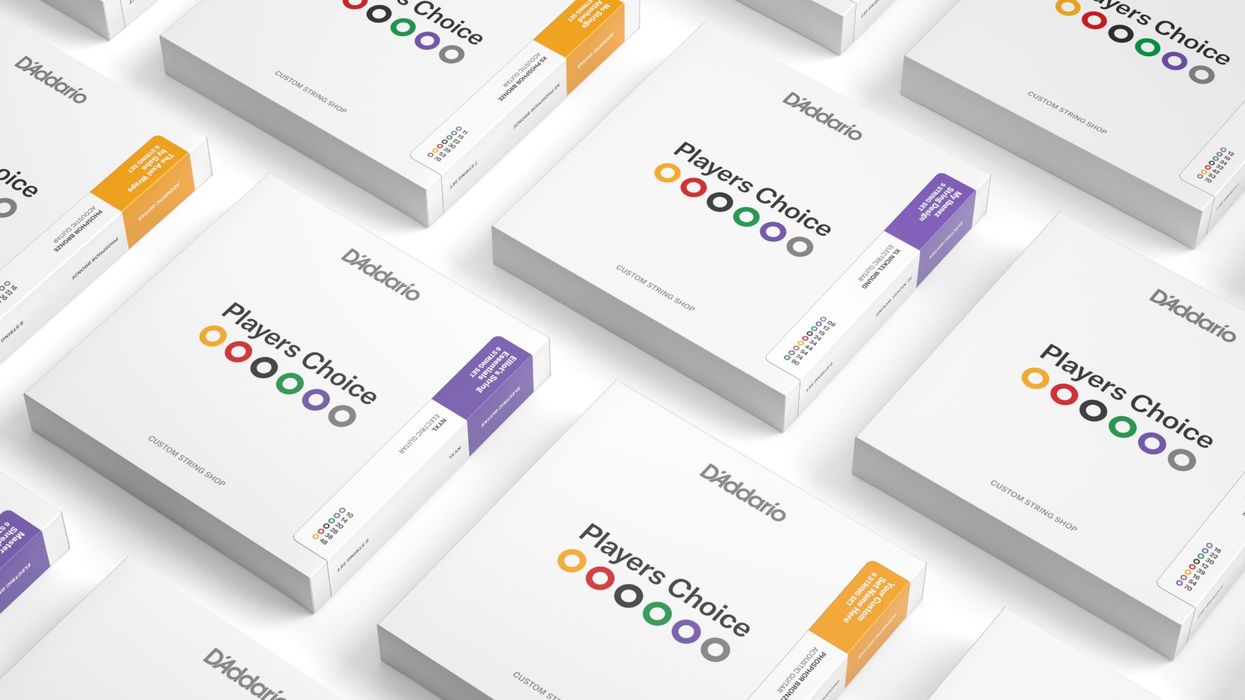
D’Addario announces the launch of the Players Choice Custom String Shop, a new online tool that lets players design their own string sets, all backed by D’Addario’s long-standing quality and craftsmanship.
Available exclusively on daddario.com, the platform allows players to select their instrument of choice and then choose from the most popular gauges and alloys across electric and acoustic guitar strings. Even better, no minimum order is required. Custom sets can be saved to a Players Circle profile for fast reorders, and every purchase you make in the Custom String Shop earns Players Circle rewards points.
From the Visionary Behind D’Addario
“Musicians looking for their ‘perfect string set’ need an intuitive way to experiment on screen and find the perfect combination of gauges and alloys to satisfy their requirements,” said legendary founder Jim D’Addario.
“We created the Players Choice Custom String Shop to satisfy everyone’s customization needs.”
Availability & Pricing

Players Choice Custom String Shop is available in the USA, Canada, and Europe, where Players Circle is available. Prices start at $10.30 for electric sets and $11.70 for acoustic sets.
Key Highlights
- Build custom sets for electric and acoustic guitars now, with support for more instruments coming in the future
- Choose from our most popular gauges and alloys, including the lightest and heaviest gauges, and even half gauges
- Design sets for standard 6- and 12-string guitars, as well as extended-range 7-, 8-, and 9-string guitars
- Choose from our most popular strings, including industry-standard XL, Chromes, and Phosphor Bronze strings. Or upgrade to premium NYXL and XS coated options
- Name your set, printed right on the label
- No minimum order quantity
- Save, reorder, and earn Players Circle rewards
Learn more! www.daddario.com/custom-strings
Guitarist Mike Scott Tells Us All the Prince Stories | 100 Guitarists Podcast
Hit-making guitarist Mike Scott—who’s worked with everyone from Justin Timberlake to Janet Jackson—showed up in Minneapolis from his hometown of D.C. and started snatching everyone’s gigs. Soon, he ended up at Paisley Park, jamming with the man himself and joining his band, New Power Generation.
This masterful storyteller joins 100 Guitarists to talk all things Prince, cracking us up along the way with firsthand recollections of playing onstage and in the studio, the only time he played the “Purple Rain” solo live, and some insight on Prince and his gear.
Thanks to our sponsor EMG

LEARN MORE! emgpickups.com
Guitarist Mike Scott Tells Us All the Prince Stories | 100 Guitarists Podcast
Hit-making guitarist Mike Scott—who’s worked with everyone from Justin Timberlake to Janet Jackson—showed up in Minneapolis from his hometown of D.C. and started snatching everyone’s gigs. Soon, he ended up at Paisley Park, jamming with the man himself and joining his band, New Power Generation.
This masterful storyteller joins 100 Guitarists to talk all things Prince, cracking us up along the way with firsthand recollections of playing onstage and in the studio, the only time he played the “Purple Rain” solo live, and some insight on Prince and his gear.
Thanks to our sponsor EMG

LEARN MORE! emgpickups.com
Electro-Harmonix Releases the Pico Swello Attack Envelope
Electro-Harmonix is excited to introduce the Pico Swello Attack Envelope pedal. Inspired by the legendary POG2 ATTACK slider, the core effect of the Swello is a polyphonic attack filter which applies individual volume swells to each note you played, even within chords and through sustained arpeggios. This unique effect is paired with an adjustable Low Pass Filter for smooth swells and envelope filter-style effects.
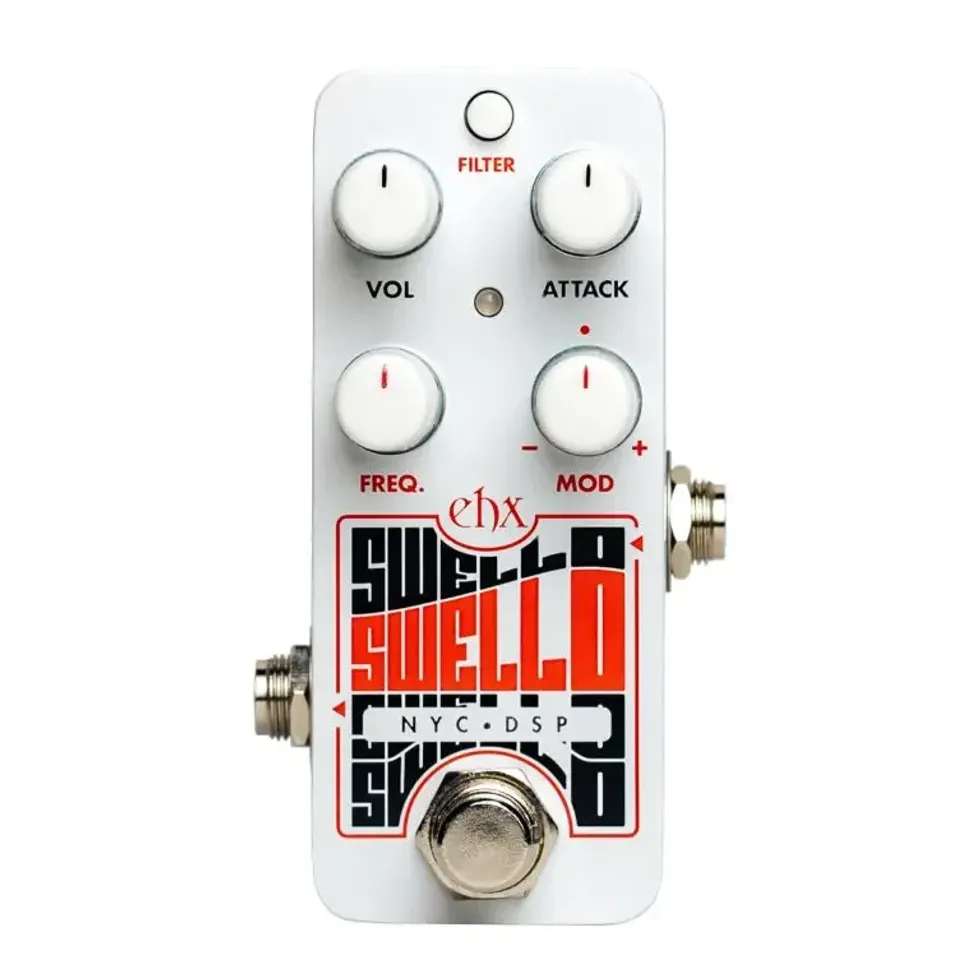
Housed in EHX’s Pico-sized chassis, the Swello has a simple four knob/one button layout. VOL adjusts the overall output of the pedal while ATTACK sets the attack envelope time. Low ATTACK settings attenuate just the initial attack of your instrument, while higher settings offer epic, long note swells. The Low Pass Filter is controlled by the FILTER button as well as the FREQ and MOD knobs. FILTER engages the LPF and applies an adjustable high or low resonance setting. The FREQ knob sets the cutoff frequency of the LPF and the MOD knob controls the depth and direction of the filter modulation akin to an envelope filter. Turn MOD up from noon for an upward filter sweep or down from noon for a downward filter sweep.
The EHX Pico Swello comes equipped with a standard EHX 9 Volt power supply. It will be available Mid-September and features a U.S. Street Price of $149.50.
New Michael Schenker Group Album "Don’t Sell Your Soul," Out Oct. 3

What was already a standout moment of this year's Wacken Open Air, the world's largest metal festival, turned into something even bigger when legendary guitarist Michael Schenker pulled a surprise no one saw coming. The architect of hard rock used the world's loudest stage to announce that a brand new Michael Schenker Group studio album, titled Don't Sell Your Soul, will be released on October 3 via earMUSIC.
To mark the occasion, Schenker and his band closed the show with a world-exclusive live premiere of the new album's title track — a powerful encore that took the Wacken crowd by surprise and was met with instant enthusiasm on the muddy festival fields. You can now listen to the new track HERE.
- Don't Sell Your Soul is the second part of an album trilogy that began with 2024's My Years With UFO. This will be the first studio album for MSG since Universal in 2022.
- The album was produced by Michael Schenker and Michael Voss, and recorded with Schenker's longtime allies: Bodo Schopf (drums), Barend Courbois (bass), and Steve Mann (guitar, keys). On vocals: the impeccable Erik Grönwall (Skid Row, H.E.A.T) – undoubtedly one of the finest rock voices of his generation. Guest appearances on vocals by Robin McAuley, Dimitri "Lia" Liapakis, and Michael Voss round out the cast.
- The Michael Schenker Group was formed in 1979 and has released 12 studio albums with many different members over the years, with Schenker the only constant presence.
- Michael Schenker played in the rock band UFO and leads the Michael Schenker Group (MSG). He was an early member of the hard rock band Scorpions, a band co-founded by his elder brother Rudolf Schenker.
- Michael Schenker is regarded as one of the most influential guitarists of the 1970s, and is widely known as a legendary figure in the history of metal guitar.
Michael Schenker is an undisputed living legend and it is time to sell your soul with MSG. Let us know what you think! Michael IS doing a limited amount of interviews so let's talk and see what we can set up!
Wah-Wah 101
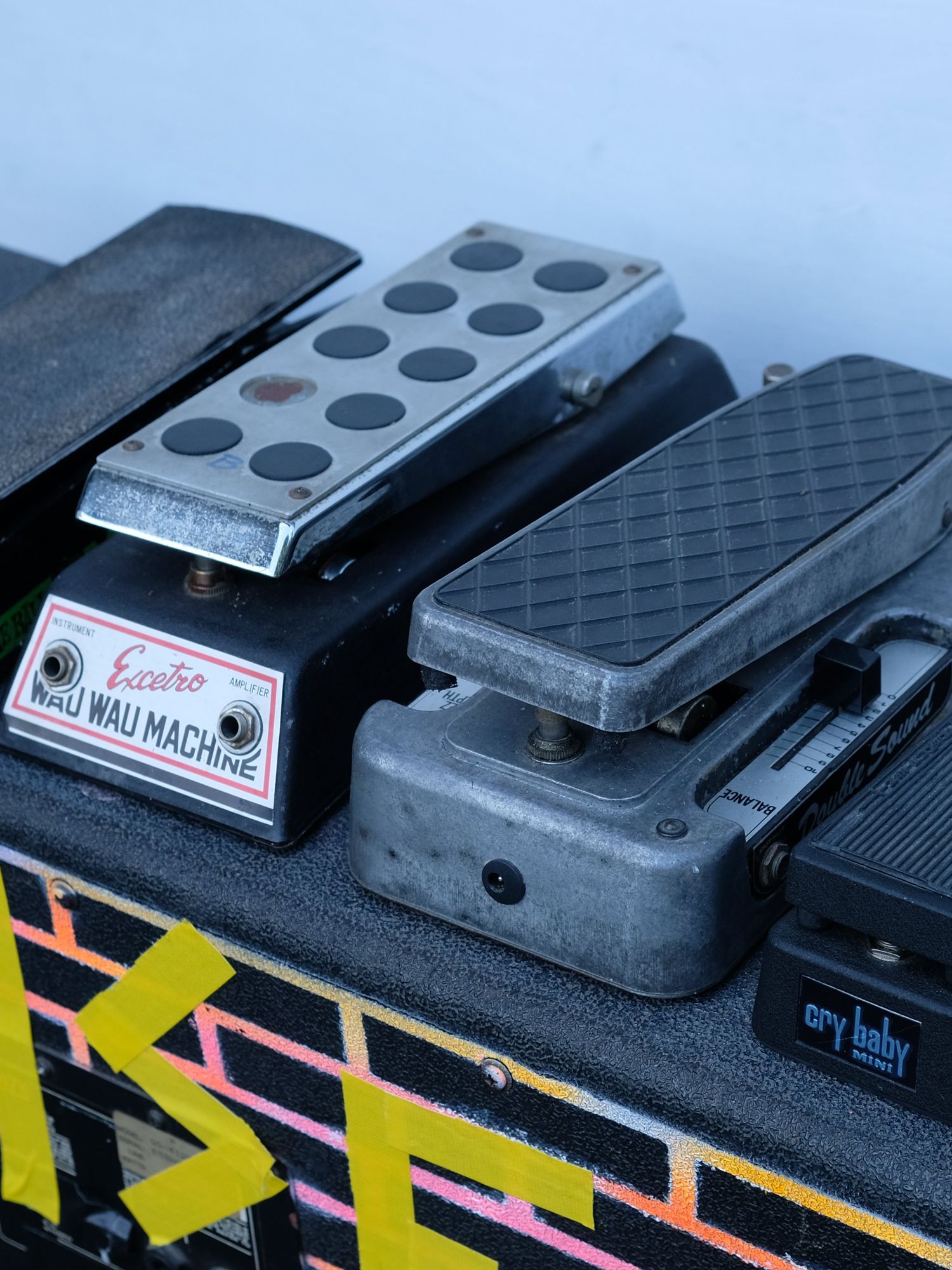
If you ask me what my favorite pedal is after fuzz, the answer is definitely wah. Bands like Fu Manchu and Dinosaur Jr. are great examples of just how powerful wah, fuzz, and a wall of amps can sound together. Sorry, I’m not into SRV voodoo or those “whacka-whacka” kinds of wah sounds.
Let’s dig a little deeper. My very first wah pedal was actually a gift from my ex-girlfriend. She told me it sounded “sexy.” She knew absolutely nothing about guitars. Maybe the sound reminded her of some sleazy ’70s B-movie soundtrack. That pedal was a Dunlop GCB95 with a red Fasel inductor. I absolutely loved it … at first. I even took it out on tour. But I grew to hate it. It was heavy, hard to click on, had no on/off LED, and it sucked tone like crazy. But still, it was the pedal that made me fall in love with wah and start digging deep into its history.
Wah is one of the most iconic effects pedals—so iconic that even non-guitarists recognize it instantly by sound alone. Hence the name—wah. The effect was first developed around 1964 by the Thomas Organ Company, an American distributor of Vox products from the U.K. Their goal? Originally, it was intended for use with Vox organs, to mimic a trumpet-like tone. Bradley J. Plunkett, a junior engineer at Thomas, modified a midrange booster circuit and eventually decided to use a potentiometer as a frequency control. The result was essentially a variable band-pass filter, initially released as the Clyde McCoy Wah-Wah. McCoy was a trumpet player, and that product was intended to achieve a muted-trumpet effect with guitar. In 1967, to better appeal to guitarists, the name was changed to the Cry Baby, although in Italy Vox branded the device as the V846 Wah-Wah—and the rest is history.
As the music industry evolved, so did the wah pedal. Both the sound and the mechanism used to operate wah pedals went through significant changes. The original Vox V846 used a variable band-pass filter housed in an organ volume pedal enclosure, where the potentiometer was turned via a gear. This allowed players to control the frequency range with a rocking foot motion. This design is still used today by many manufacturers.
However, that system has its drawbacks. Over time, the gears wear out due to friction. Then, there’s the issue of limited sweep range: most rotary pots have about 270 degrees of rotation, but gear mechanisms often only utilize about a third of that, making them far from optimal. In 1977, Ernie Ball replaced the gear mechanism with a string-loop-and-spring design, allowing for a full and smooth sweep. Roland and Boss also introduced unique approaches, including automotive-like axle designs and pedal mechanisms inspired by bicycle cranks—equally effective and efficient. Morley, meanwhile, took a more futuristic approach by employing optical sensors to control the sweep, with no moving interior parts at all.
“Perhaps due to their legacy tones, many players enjoy the limitations of the original design.”
Despite these innovations, no single mechanism has rendered the others obsolete. In the end, it’s up to the musician—the user—to decide which design works best for their playing style and live performance needs. I find myself more comfortable with devices like the one from Ernie Ball, simply because they include an LED indicator. I also really love the Dunlop Bass Wah—essentially a manual envelope filter—which I think is genius.
That said, the classic gear-style wah pedals still have their loyal fans. Perhaps due to their legacy tones, many players enjoy the limitations of the original design. I still believe the lack of an on/off LED indicator is the biggest flaw in traditional wahs like the Cry Baby or Vox models.
Maybe I’m just one of those people with unorthodox tastes and needs. I don’t claim to be special or different, but wah pedals are tools for making music, and music-making is by nature a subjective process. And that’s totally okay, right?
In fact, I’m sure many of the innovations we’ve seen in wah pedal design come from the designers’ own subjectivity—trying to solve real problems they perceive in real contexts. As long as people are passionate about making music, new ideas will keep emerging. Weird, wonderful, and always evolving—that’s wah.
Bass Legends’ Pedalboards: Justin Chancellor, Tim Commerford, MonoNeon and more!
Re-live classic Rig Rundowns from Tool’s Justin Chancellor, Pantera’s Rex Brown, Tim Commerford (RATM/Prophets of Rage), MonoNeon (Prince), and other road-tested pros as they reveal the routing, wah/whammy tricks, delay math, and looping workflows that truly hold up onstage.
Watch the FULL Rig Rundowns:
Tool’s Justin Chancellor: https://www.youtube.com/watch?v=OlbvMpq4C64
Pantera’s Rex Brown: https://www.youtube.com/watch?v=GYPG6SQlupQ
Donny Benet: https://youtu.be/WHR5aPTYs4E
MonoNeon: https://youtu.be/fjHgrc06Ov8
Blu DeTiger: https://youtu.be/gVLSMnVID4Q
Tim Commerford: https://www.youtube.com/watch?v=JsgUqLdgQ1U
El Ten Eleven: https://youtu.be/3wpkBijUkok
Brought to you by D’Addario: https://ddar.io/wykyk-rr
Join D’Addario’s Players Circle for free today to start earning points toward free gear: https://ddar.io/pc-rr Noise Engineering Batverb Review
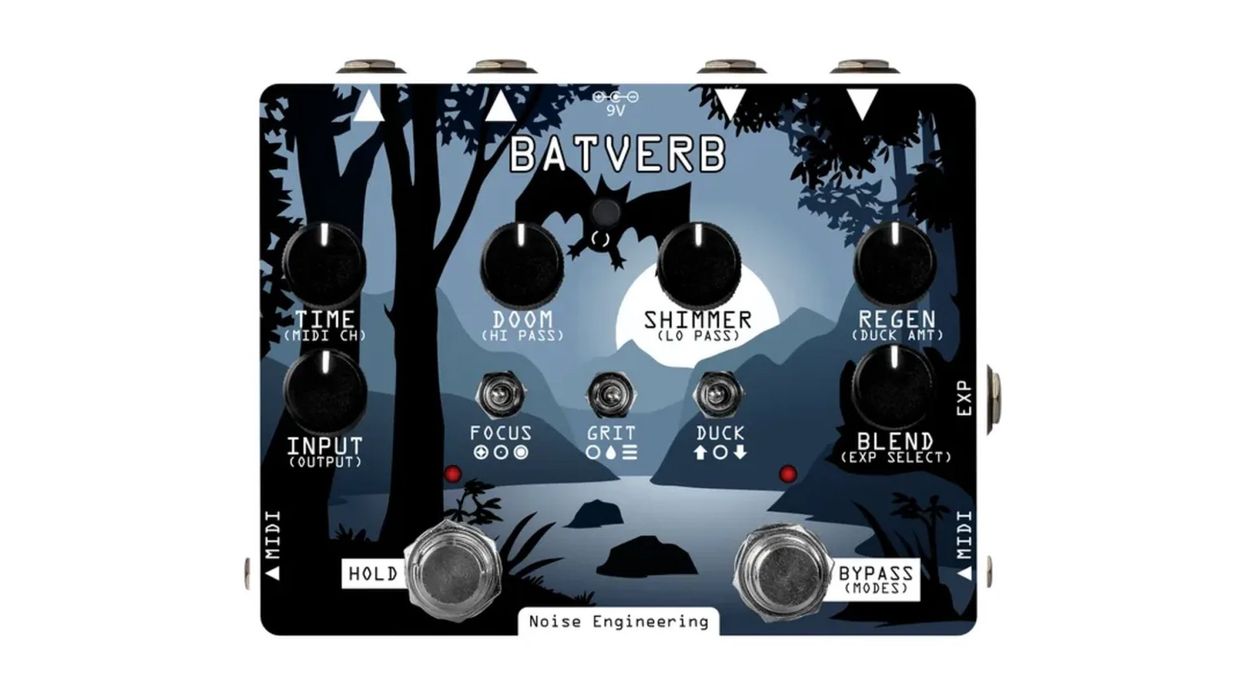
When California-based effects company Noise Engineering released their Desmodus Versio in 2020, it represented the first reverb effect in their product line, but they coined a new term for the DSP-based effect: a synthetic-tail generator. The name reflects the reality that it is, by definition, the Desmodus Versio doesn’t create literal reverberation, as in reflections in a room, but instead builds “tails” onto an audio signal. Taxonomy aside, it was a powerful, well-received, and positively jam-packed digital unit.
The Batverb, launched earlier this year, is an evolution of Noise’s tail-generating efforts. However, it uses brand-new code programmed for Electrosmith’s Daisy Seed DSP platform. A stereo effect box that spans delightful and demented flavors of delay and reverb, the Batverb is generously featured and full of unique takes on space-making effects.
Heads or Tails
The Batverb’s main panel includes six knobs, three 3-way switches, two footswitches, and one “bat” button, which you press and hold to access alternate parameters assigned to the knobs. On the crown are input jacks for either mono or stereo performance as well as MIDI in/out and expression pedal jacks. Up to 16 different presets can be saved and recalled via MIDI.
In normal operation, the knobs govern, from bottom left to bottom right, input volume, time, a suboctave chorus, an octave-up shimmer, “regen” or feedback, and a blend of dry and wet signals. When holding the bat button, those same knobs, in order, control output volume, MIDI channel selection, high-pass filter, low-pass filter, duck amount, and expression pedal parameter assignment. The focus switch changes the diffusion of the delay lines. In the left position it behaves more like a delay, while the other two settings sound and feel more like reverbs. Grit adds, in the middle and right positions, a discrete soft-clipping distortion, and duck determines the responsiveness of the feedback. In the switch’s center position, there’s no ducking. At left, feedback monetarily increases when input volume is received, then tapers off as the signal does. At right, the opposite happens, and feedback increases as the signal gets quieter.
Enter the Bat Cave
To my ears, the Batverb’s more reverb-y patches are in hall or room territory—albeit very cavernous halls or rooms. But reverb sounds created by the Batverb’s algorithms sound more authentic to me than many sought-after reverbs I’ve played. Rather than an indistinct wash of sound, the tails here give the convincing impression of your amp’s signal ricocheting around a high-ceilinged cathedral, at first coming back in clearer, sharper bursts, then melting into smeary ambience. And the handy hold feature can be engaged for infinite regeneration by tapping the footswitch, or for a specific window by pressing and holding. That double utility goes a long way toward determining whether the Batverb sounds organic or unhinged.
The sub- and up-octave content injected by the doom and shimmer knobs is more chaotic and spacious than garden-variety iterations of those effects you’ll find on many octave-based reverbs, and that’s a good thing. Like most effects generated by the Batverb it feels like the product of thoughtful, well-considered programming.
The delay algorithm, engaged with the focus toggle at left, is pleasant and plenty usable, and it’s nice to have alongside the less predictable reverb settings. But the Batverb’s deep tweakability means you can still dial in a broad range of both standard and more marginal delay sounds. The chunky transistor-ish dirt summoned by the grit switch widens the palette further. Add in the touch-sensitive ducking (and its customizable parameters), and you’ve got a ton of ground to play with.
The Verdict
Noise Engineering created an outstanding reverb and tail generator here. Considering its steep asking price, the Batverb will be out of the question for many players, but it’s obviously geared to adventurous players and discerning producers, especially those looking for authentic, parallel universe-conjuring ambience and noise in their studio or live rigs. For these musicians, the Batverb will be more than worth the bite it takes from the bank balance.
Filmmaker and Musician Jim Jarmusch on Guitars, Music, & Magic
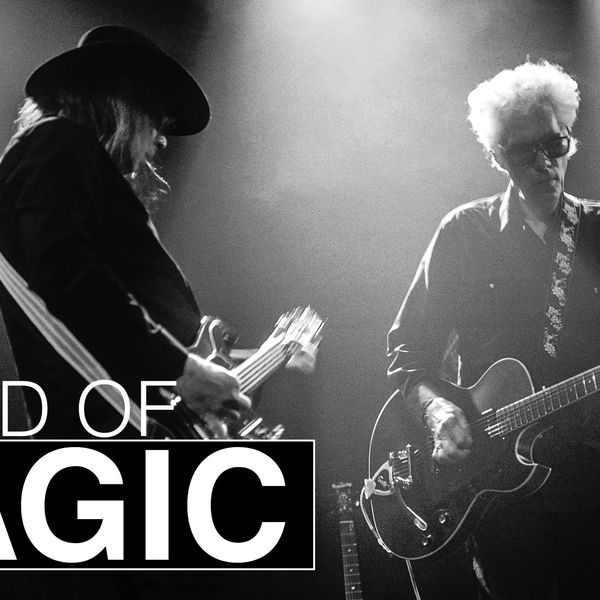
Filmmaker Jim Jarmusch—one of the creative avatars of downtown New York cool since the mid ’80s—was asked a while back what he thought were some of the key innovations of the 20th century. “My answer was the mapping of the human genome, the Hubble Space Telescope, the French bikini, and the electric guitar,” recalls the director of such arthouse wonders as Mystery Train, Dead Man, and Only Lovers Left Alive. “My favorite of those might be the electric guitar. I just love guitars and musical noise.”
YouTube
Jarmusch isn’t just a fan of music ranging from the Stooges and Crazy Horse to heavy drone bands like Earth and Nadja. He generates guitar noise himself, most notably with his band Sqürl and his frequent duo partner, the Dutch lutenist Jozef van Wissem. Jarmusch has been making records and performing live with both for years now; his output with a guitar in hand has even lately outpaced his productivity behind a camera. Last year, he and his prime Sqürl mate, Carter Logan (drums/electronics), released Music for Man Ray, an album of their scores to Surrealist short films made by the titular artist in the 1920s, the whorls of sound captured live at the Centre Pompidou in Paris. That disc followed a 2023 Sqürl studio album, Silver Haze, with guest stars guitarist Marc Ribot, actress/vocalist Charlotte Gainsbourg, and the singer-songwriter Anika. Jarmusch and van Wissem toured this summer to herald a new record, The Day the Angels Cried, their fifth non-soundtrack release. Jarmusch has also been working on some longform solo guitar music, asking the recording engineer to “edit out all the riffs” as he follows a dream-logic muse.
“You have to be listening and use your whole body along with your instrument, your amps, your effects. But what you’re going to produce isn’t certain, and there’s tension in that.”—Jim Jarmusch
Although he had played in bands during the early ’80s, mostly on keyboards, Jarmusch took up the guitar as a passion in the early 2000s. He had planned for his pensive noir The Limits of Control (2009) to feature preexisting music rather than a purpose-written score, including viscous art-metal by Boris, Sunn O))), and Earth, the tolling psychedelic rock of the Black Angels’ “You on the Run,” and a handful of flamenco pieces to suit the Spanish setting. But when he couldn’t find the right tracks to match some elemental sounds he heard in his head for a few remaining scenes, Jarmusch decided to make that music himself, alongside Logan and engineer-organist Shane Stoneback. Credited as Bad Rabbit on the soundtrack, the name morphed into Sqürl as Jarmusch and Logan released further recordings, such as the luminous, affecting Some Music for Robby Müller (a sonic tribute to the late, great cinematographer).
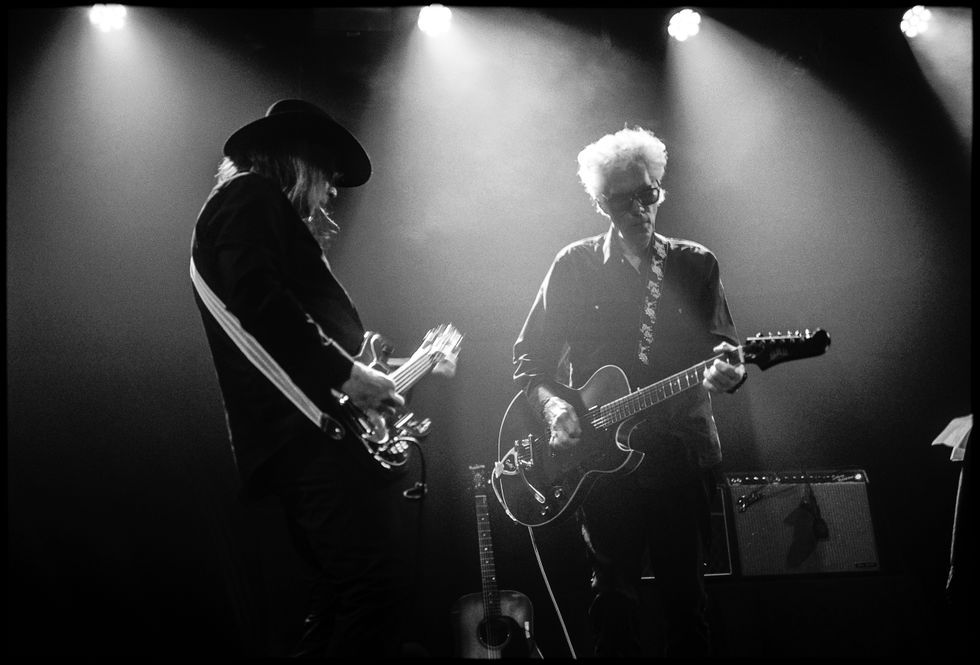
“I’m not a trained guitar player—never even had a real lesson,” explains Jarmusch, 72. “I play my own way. I don’t practice scales, but something I have practiced for many years is controlled feedback. If I can say anything, it’s that I’ve become pretty good at that kind of musical feedback on electric guitar, something I do a lot in the duo with Jozef. I have had some pointers in this area, particularly from Stephen O’Malley from Sunn O))) and Stewart Hurwood, one of Lou Reed’s guitar techs. But the thing about feedback is that you’re not always totally in control of it. You don’t know exactly how the guitar and pickups are going to react vis-à-vis what distance you are from the amplifiers and how their levels are set. So, you have to be listening and use your whole body along with your instrument, your amps, your effects. But what you’re going to produce isn’t certain, and there’s tension in that. I’m always interested in the challenge of being a little off-balance—it inspires me. I’m not so good at repeating a formula, as I’m not mathematical in that way. When playing more rock ’n’ roll guitar with Sqürl, I can even sort of frustrate Carter at times, because he’s a precise drummer and my approach is on the loose side.
Primal Sounds, Old Wood
When it comes to his ethos of guitar, clues come from the two documentaries Jarmusch has made: the exciting, insightful Stooges history Gimme Danger (2016) and the lo-fi road document Year of the Horse, which Neil Young called “a nature film” of his 1996 tour with Crazy Horse. “I’m definitely not into shredding, even if you can admire the technical mastery of someone like Eddie Van Halen,” Jarmusch says. “I’m a Ron Asheton guy—in the more primal camp. I really like Neil’s raw style. I’m drawn to players who approach the instrument from an odd slant.” He points to Ribot, Link Wray, Robert Quine, and Rowland S. Howard of the Birthday Party as other individualists he finds inspiring, along with Earth’s Dylan Carlson for “his beautiful sound and incredible control” at glacial tempos, and Pat Place of the Contortions and Bush Tetras, “who brought such a funky vibe to the post-punk and No Wave scene in New York.”
Jarmusch lights up at memories of witnessing Television live, calling the interplay of Tom Verlaine and Richard Lloyd “a beautiful revelation—this weaving of guitars that wasn’t necessarily blues-based. Their shows would just elevate me to the sky.” He also digs the live-wire, sui generis guitar weave of Ibrahim Ag Alhabib and his mates in the nomadic Saharan band Tinariwen, as well as the drone-metal pairing of O’Malley and Greg Anderson in Sunn O))) and the intrepid avant-rock of Sonic Youth’s Thurston Moore and Lee Ranaldo.
Jim Jarmusch’s Gear
Guitars
Fender Stratocaster modified by Rick Kelly with Seymour Duncan Quarter Pound pickups, Callaham bridge, and leather pickguard by Cindy Guitars
Rick Kelly T-style
Guild Starfire I Jet 90 with three P-90 pickups
Fender Ed O’Brien Stratocaster
Epiphone Casino
Epiphone ES-335
Fender Jaguar
Blueridge Dreadnought
Gibson L-1
Guild mahogany dreadnought 12-string acoustic
Gretsch Bobtail Roundneck Resonator G9220
1960 Silvertone Jupiter
Amplifiers
Vox AC15
Fender Pro Junior
Roland Jazz Chorus
Silvertone 1482
Vox Pathfinder 15R
Effects
EarthQuakerDevices Dispatch Master
EarthQuakerDevices Avalanche Run
EarthQuakerDevices Transmisser
EarthQuakerDevices Astral Destiny
EarthQuakerDevices Hizumitas
EarthQuakerDevices Spires
EarthQuakerDevices Special Cranker
EarthQuakerDevices Aqueduct
EarthQuakerDevices Rainbow Machine
EarthQuakerDevices Warden
EarthQuakerDevices Acapulco Gold
Death by Audio Echo Master
Gamechanger Audio Plus Sustain
Gamechanger Audio Plasma
Electro-Harmonix Deluxe Memory Man (vintage)
Electro-Harmonix Pitchfork
Electro-Harmonix 720 Looper
Electro-Harmonix Voodoo Lab Overdrive
Boss Super Overdrive SD-1
Boss Compression Sustainer CS-3
Boss Loop Station RC-3
Boss Space Echo RE-20
Boss Catalinbread Echorec
MXR Carbon Copy
Chase Bliss Mood
Chase Bliss Generation Loss
Kernom Moho Fuzz
Dunlop TS-1 Stereo Tremolo
TrueTone CS12
Death By Audio Raw Power
Strings
D’Addario .010s

Like some of his favorite players, Jarmusch’s go-to shop is Carmine Street Guitars in New York’s West Village, whose customers have also included Quine, Ribot, Lou Reed, Bill Frisell, Nels Cline, and Lenny Kaye. The proprietor, Rick Kelly, is a luthier whose specialty is creating guitars made out of rare, especially resonant 19th-century wood sourced from New York City buildings, including McSorley’s Ale House (established in 1854) and the roof of Jarmusch’s Bowery loft. He calls Kelly “my main guy—a real artisan and just fascinating to talk with about guitars, tonewoods, everything.” Kelly built Jarmusch a custom T-style (with a wide-range humbucker at the neck), along with modifying his longtime road guitar for Sqürl: a black Stratocaster, with Seymour Duncan Quarter Pound pickups and other touches. Jarmusch appreciates the store’s old-school, workshop vibe so much that he encouraged a documentarian friend of his, Ron Mann, to make a charmer of a film called Carmine Street Guitars, which features Jarmusch and many of the aforementioned players stopping in to talk about the shop’s instruments and try them out.
“Making a film is a complex process with a lot of equal talents all pulling together, yet I’m necessarily the captain of the ship, navigating an idea from my imagination onto the screen. But when I’m making music with other people, I’m in a conversation.”
Jarmusch’s other favored guitars include a Blueridge dreadnought and an Ed O’Brien signature model Stratocaster. “The Ed O’Brien Strat with that Fernandes Sustainer unit is an amazing guitar, kind of trippy,” he says. “Whenever I pull that thing out in my little studio, the instrument almost starts playing itself, like it just wants you to experiment with it.” For the squalling counterpoint he provides to van Wissem’s circular arpeggios, Jarmusch switches to a semi-hollow guitar. “I have a cool 335-style Epiphone from the 1990s that feeds back beautifully, sounding like a cello. I played it for almost all the past recordings where I used feedback a lot. But for my latest tour with Jozef, I have been using a Guild Starfire Jet that has three P-90 pickups. It’s kind of a beast, but I’m loving it, because it’s very good for controlled feedback.”
Analog Spirit, Drone Power
About Jarmusch’s romance with guitars, van Wissem says, “I guess it was sort of an accident that the guitar and music became a bigger and bigger focus for Jim, but I always had the idea that he really wanted to be a musician, in a way. He has definitely become a good guitarist now, having developed his own sound and approach over the years. He loves his pedals and playing wild electric stuff and feedback, but he likes playing acoustic, too. We can go from darkly beautiful, even elegant things to some pretty metal sounds, especially at the climax of these recent shows when I trade the amplified lute for a 12-string guitar, my Gretsch Electromatic.”
Jarmusch and van Wissem hit it off after meeting on the street in SoHo about 20 years ago. “We immediately discovered that we shared an enthusiasm for many of the same films and books, and music from Morton Feldman to Joy Division,” van Wissem recalls. “Jim is a cultural sponge—he takes everything in.” The two developed a synergistic association, performing around New York with their unique combination of instruments and making records often colored by van Wissem’s arcane, neo-gothic mythos. The lutenist, playing models made for him by Canadian luthier Michael Schreiner after Renaissance and Baroque examples, had already been recording his own minimalist, contemplative compositions solo, having eschewed a traditional route of playing the complex classical repertoire (despite a love for such Baroque lutenist-composers as Sylvius Leopold Weiss). The aim, van Wissem says, was to “dust off” the lute by putting its intimate tones in a new context, “to make it live in the now.” It was a path more in keeping with his punk-rock spirit, something the indie-minded Jarmusch could appreciate.
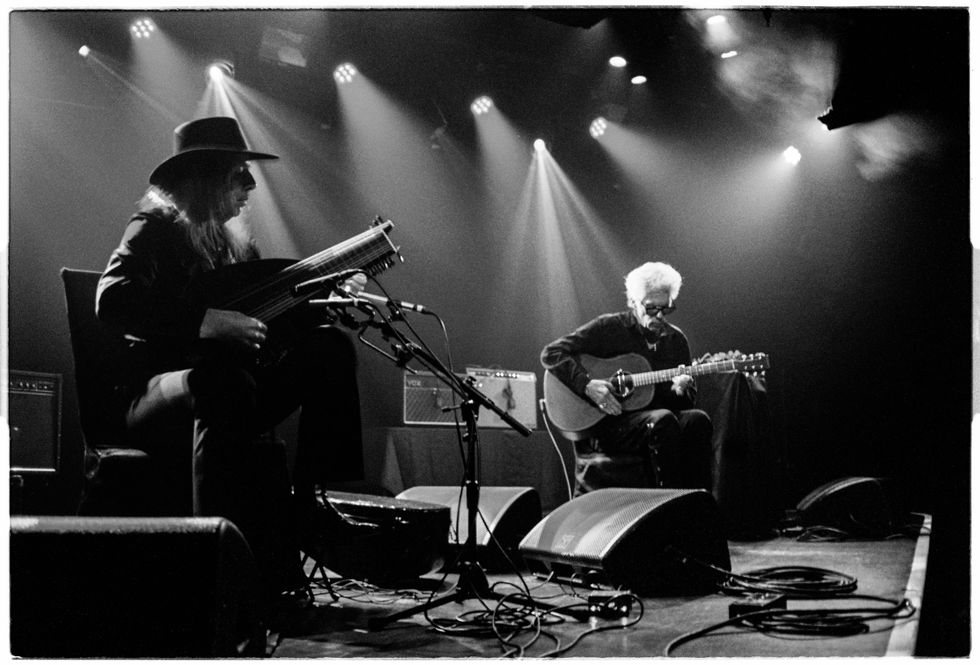
About Jarmusch’s romance with guitars, van Wissem says, “I guess it was sort of an accident that the guitar and music became a bigger and bigger focus for Jim, but I always had the idea that he really wanted to be a musician, in a way. He has definitely become a good guitarist now, having developed his own sound and approach over the years. He loves his pedals and playing wild electric stuff and feedback, but he likes playing acoustic, too. We can go from darkly beautiful, even elegant things to some pretty metal sounds, especially at the climax of these recent shows when I trade the amplified lute for a 12-string guitar, my Gretsch Electromatic.”
“David Lynch said that movies are the closest thing that humans make to dreams, and it’s true. A film is like a dream that you’re pulled into. But music is more like a kind of magic, even just listening to it. You supply your own imagination, your own feelings and associations.”
Jarmusch and van Wissem hit it off after meeting on the street in SoHo about 20 years ago. “We immediately discovered that we shared an enthusiasm for many of the same films and books, and music from Morton Feldman to Joy Division,” van Wissem recalls. “Jim is a cultural sponge—he takes everything in.” The two developed a synergistic association, performing around New York with their unique combination of instruments and making records often colored by van Wissem’s arcane, neo-gothic mythos. The lutenist, playing models made for him by Canadian luthier Michael Schreiner after Renaissance and Baroque examples, had already been recording his own minimalist, contemplative compositions solo, having eschewed a traditional route of playing the complex classical repertoire (despite a love for such Baroque lutenist-composers as Sylvius Leopold Weiss). The aim, van Wissem says, was to “dust off” the lute by putting its intimate tones in a new context, “to make it live in the now.” It was a path more in keeping with his punk-rock spirit, something the indie-minded Jarmusch could appreciate.
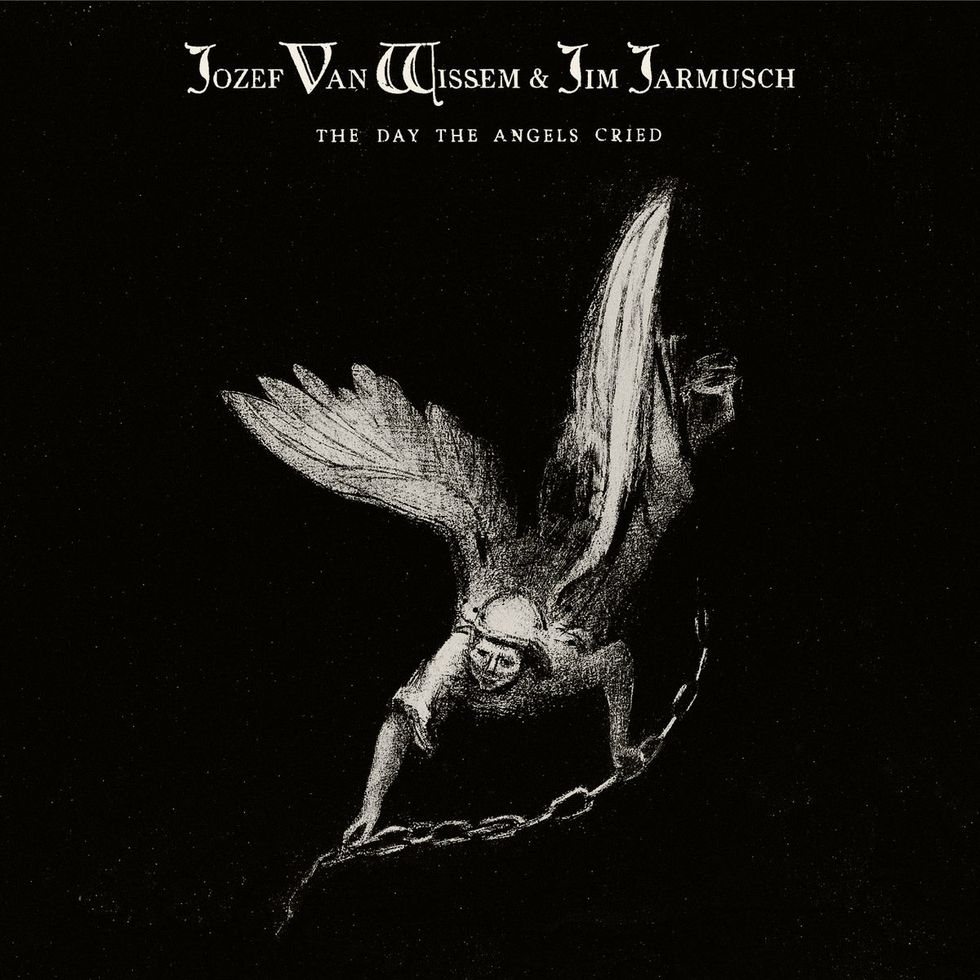
A milestone for the Jarmusch/van Wissem partnership came with the soundtrack for Only Lovers Left Alive (2013), the director’s most potent latter-day film. Although ostensibly a vampire movie, on a deeper level it’s about valuing the gifts of the past while also appreciating new possibilities ahead, despite the melancholy evanescence of this world. The score is a mosaic of Sqürl and van Wissem, with the lutenist composing the main themes—which earned him the soundtrack award at the Cannes Film Festival. It’s also the duo’s “hit,” the one crowds cheer from the first notes.
Reflecting on his various collaborations, Jarmusch says: “Making a film is a complex process with a lot of equal talents all pulling together, yet I’m necessarily the captain of the ship, navigating an idea from my imagination onto the screen. But when I’m making music with other people, I’m in a conversation. With Sqürl, I can lead things, or not. But in the duo with Jozef, he generally makes the decisions on structure, etc., which I’m then free to react to. I like that. Giving up control is good for me, and he has experience making his own records. He has always encouraged my musicality, and I trust him. Our interest in history and our sense of aesthetics align in many ways, even if our philosophies differ in some areas. I see Jozef as this Swedenborgian mystic in a way, whereas I’m a natural-phenomenological psychedelic atheist, I guess.”
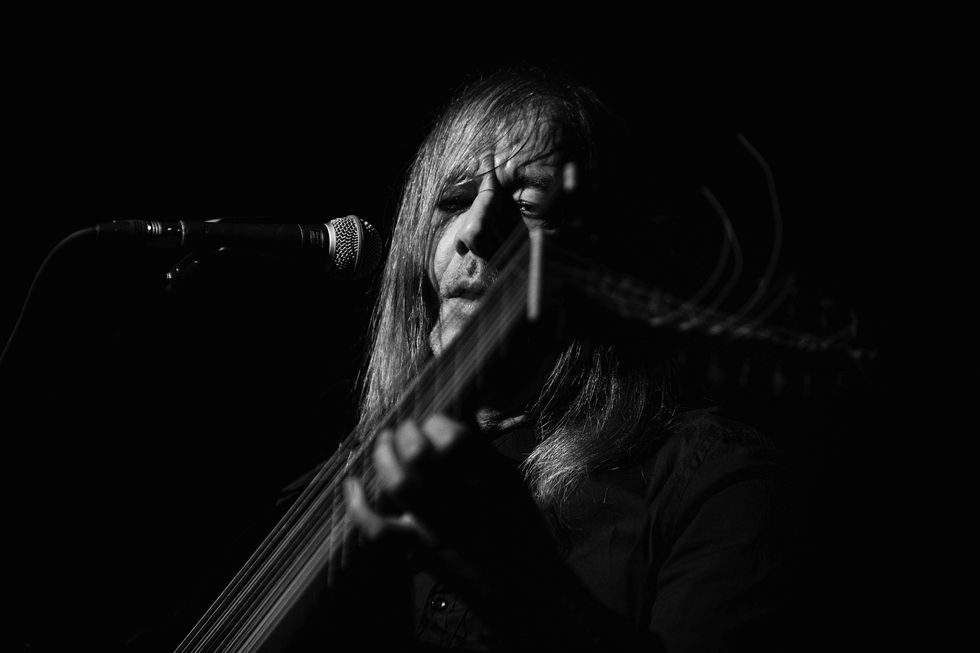
Jarmusch and Van Wissem certainly share an appreciation for the timeless power of the drone. The pick of their albums, American Landscapes, comprises three droning tone poems created in 2022 to reflect the embattled state of the nation, like an alarm-cum-lament, with the lute tolling as the guitar growls at the moon. But all of the duo’s music-making taps into a hypnotic essence. “I’ll be playing one chord, arpeggiated, for a long time, circling around, and that repetition can put a listener into something like a trance,” Van Wissem explains. “On the lute, I’m playing Renaissance drones, essentially, alternating the bass line on two strings and improvising a melody on top, the drone staying the same with some variation in the melody. It’s basic, but that trance effect at a show means you go more inward. You let things go in the process, your daily disturbances, and when it’s over, you’re different somehow. I have the same experience when I go to a Sunn O))) concert.”
Due out this fall is Jarmusch’s first movie since 2019, Father, Mother, Sister, Brother, starring Charlotte Rampling, Cate Blanchett, Adam Driver, and Tom Waits. Jarmusch tells a story involving Waits that helps illustrate a difference for him between directing movies and making music: “Once, I was with Tom at his house, and he’s sitting at this old piano and writes a song as I’m sitting there. It just comes and then goes into the ether, like perfume. At the time, I had been working on a film for two fucking years, with longer to go, and he conjured up this wonderful piece of art in the moment. Making films doesn’t have that immediacy. David Lynch said that movies are the closest thing that humans make to dreams, and it’s true. A film is like a dream that you’re pulled into. But music is more like a kind of magic, even just listening to it. You supply your own imagination, your own feelings and associations. Filmmaking is something that I love to do and hope to keep doing. But music is in another realm. I think it’s the most beautiful thing that humans do.”
YouTube It
Here’s a flashback to Jarmusch and van Wissem earlier in their union, creating droning magic in Barcelona in 2013.
MOOER Expands Its Multi-Effects Range with the GE150 Max and GE150 Plus
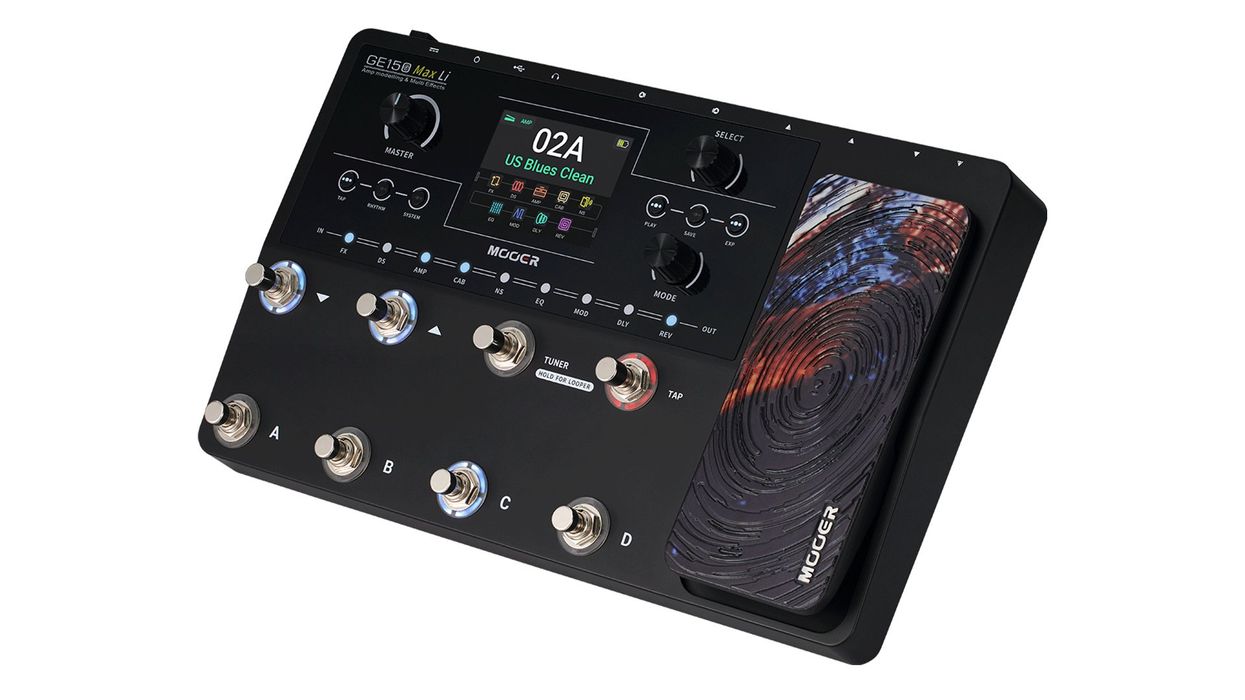
Since its initial release in 2019, MOOER’s critically acclaimed GE150 has seen several significant improvements, including through the GE150 Pro and the more recently announced GE150 Plus. However, the latest addition to the series, the GE150 Max, includes some of the most impactful additions to the series so far, all while staying true to the device’s existing functionality.
For existing GE150 users, the first thing they will notice is that, rather than having just two multi-functioning footswitches as with the original, the GE150 Max includes 8. Four of these footswitches are dedicated to switching between the four presets of each bank, whereas a further two are used to switch between banks. This is in contrast to other MOOER multi-effects pedals, where pressing two preset switches would typically shift the banks, with the new system making bank changes more accessible during a performance.
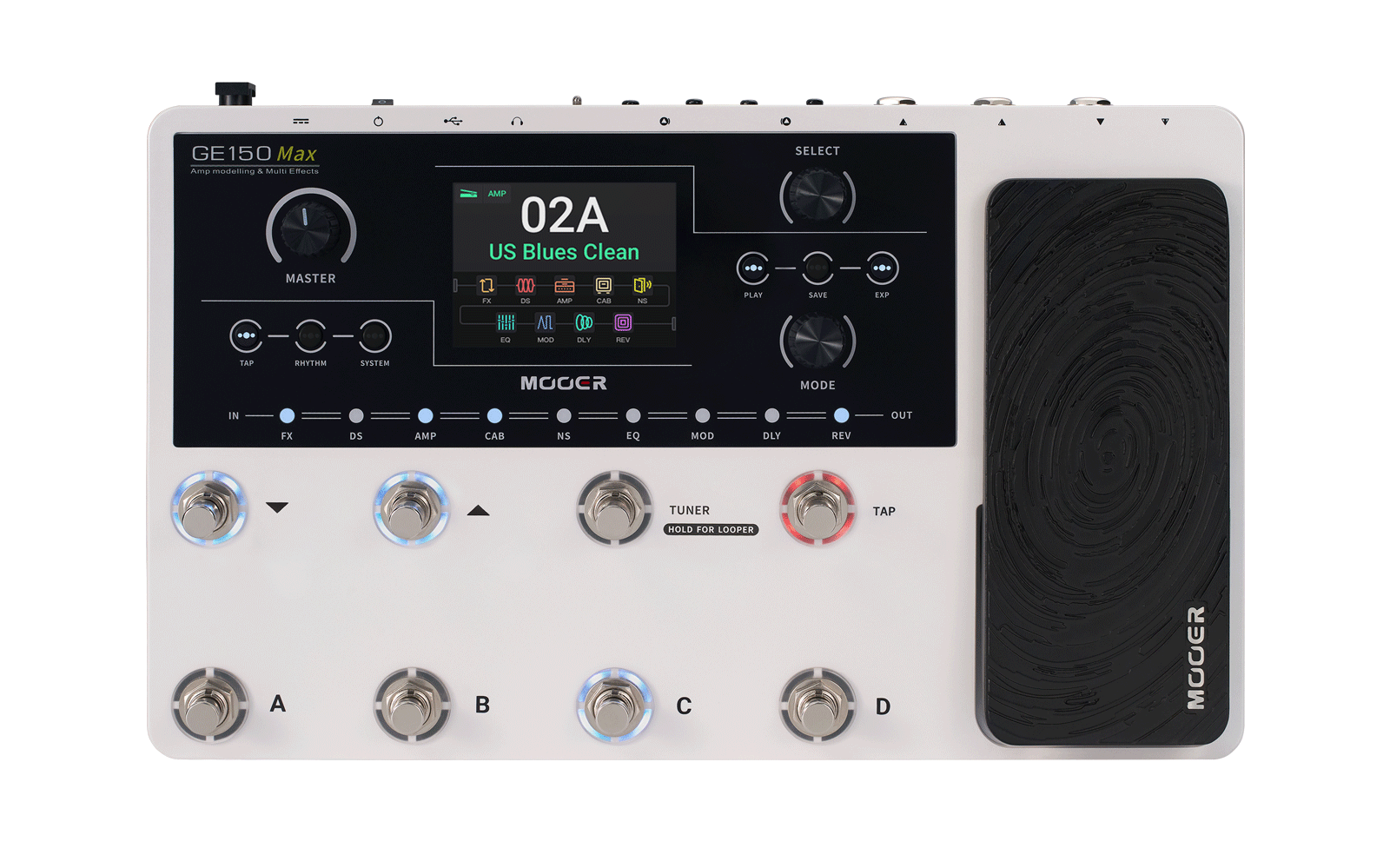
The remaining two footswitches are used to activate the tuner function, the 80-second looper system, and to determine the universal tap tempo. Despite these control mechanism changes, the GE150 Max has retained its predecessor's range of preloaded tones and effects. 50 preset banks are provided, each with 4 presets, totalling 200 customizable slots.
Many different models of delay, reverb, and modulation effects can be applied to these slots, but most importantly, the device comes with 55 preamp models, each of which is based on nonlinear modeling technology, helping to produce realistic emulations of classic amplifier tones. However, users are not limited to these tones, as the GE150 Max also supports MOOER's MNRS amp sampling system, in addition to third-party IR files for cabinet emulations, allowing users to greatly expand the device's tones through uploading their own.
To visualize the tones and effects that are currently loaded, the device is fitted with a 3.5" LCD color display, providing real-time visual feedback on the effect chain and each module's parameters. To edit these, the "Select" and "Mode" dials can be used, enabling guitarists to quickly create their own effects chains and then save them. Interestingly, the effect chains also support MOOER's new CTRL function, which enables users to map single effect modules to footswitches, facilitating more granular real-time control over the chain.

As with the original GE150, the Max edition sports an integrated expression pedal that can be mapped to tone and effect parameters, as well as output volume, adding yet another control mechanism for live expression. Interestingly, though, the Max has been augmented by the new "SPILL-OVER" function. Essentially, this ensures that delay and reverb effect tails will fade out naturally when switching presets, making smoother and more natural transitions possible in a live setting.
In terms of the internal drum machine and looper, MOOER has stuck to the successful formula of the original GE150. 80 seconds of looping time allow for creative improvisations and loop-based compositions, and a 40-style drum machine is also provided, complete with 10 metronomes. The previously mentioned "Tap" footswitch can be used to accurately determine the BPM of these features in real-time.
Aside from the GE150 Max's internal features, it also boasts an impressive upgrade on its audio output options. Most notably, in addition to the expected 1/4" stereo outputs, it is also fitted with a stereo balanced XLR output. Guitarists can choose this output option to shield their output from signal degradation and distortion over long-distance cables, guaranteeing a cleaner, more stable, and generally more professional live output than was previously possible.
As if this weren't enough, an Aux In port is also provided for connecting to smartphones or external audio players, allowing guitarists to jam along to their favorite backing tracks or rehearse their band's material. The device's USB port can even be used for OTG recording into a mobile device, as well as for the management of presets, sample files, and firmware through a PC. Combining this versatile selection of audio routing options with the GE150 Max’s upgraded functionality, guitarists truly have everything they need for professional-grade live performance, all within a light-weight and compact package.
Product Features
- 8 multi-purpose footswitches
- 3.5" LCD color display
- 200 preset slots across 50 banks of 4 presets
- 55 preamp models, made possible through intelligent nonlinear sample technology
- Amplifier and cabinet modules support MNRS sampling files
- Cabinet simulations support third-party IRs
- Parameter-mappable expression pedal
- CTRL function, allowing footswitches to be mapped to toggle individual modules within an effect chain preset
- Tap-tempo footswitch
- “Spill-over” functionality for smooth reverb and delay transitions during preset switches
- Built-in 80-second stereo looper
- Integrated drum machine with 40 drum patterns and 10 metronome modes
- Mono ¼” inputs and outputs
- XLR balanced output, ideal for the prevention of signal degradation over long-distance live audio routing
- Aux input port for external audio playback
- USB-C port for tone editing, recording, firmware updates, and mobile device connectivity (via OTG)
The GE150 Max will be available from the official distributors and retailers worldwide on 10th September 2025.
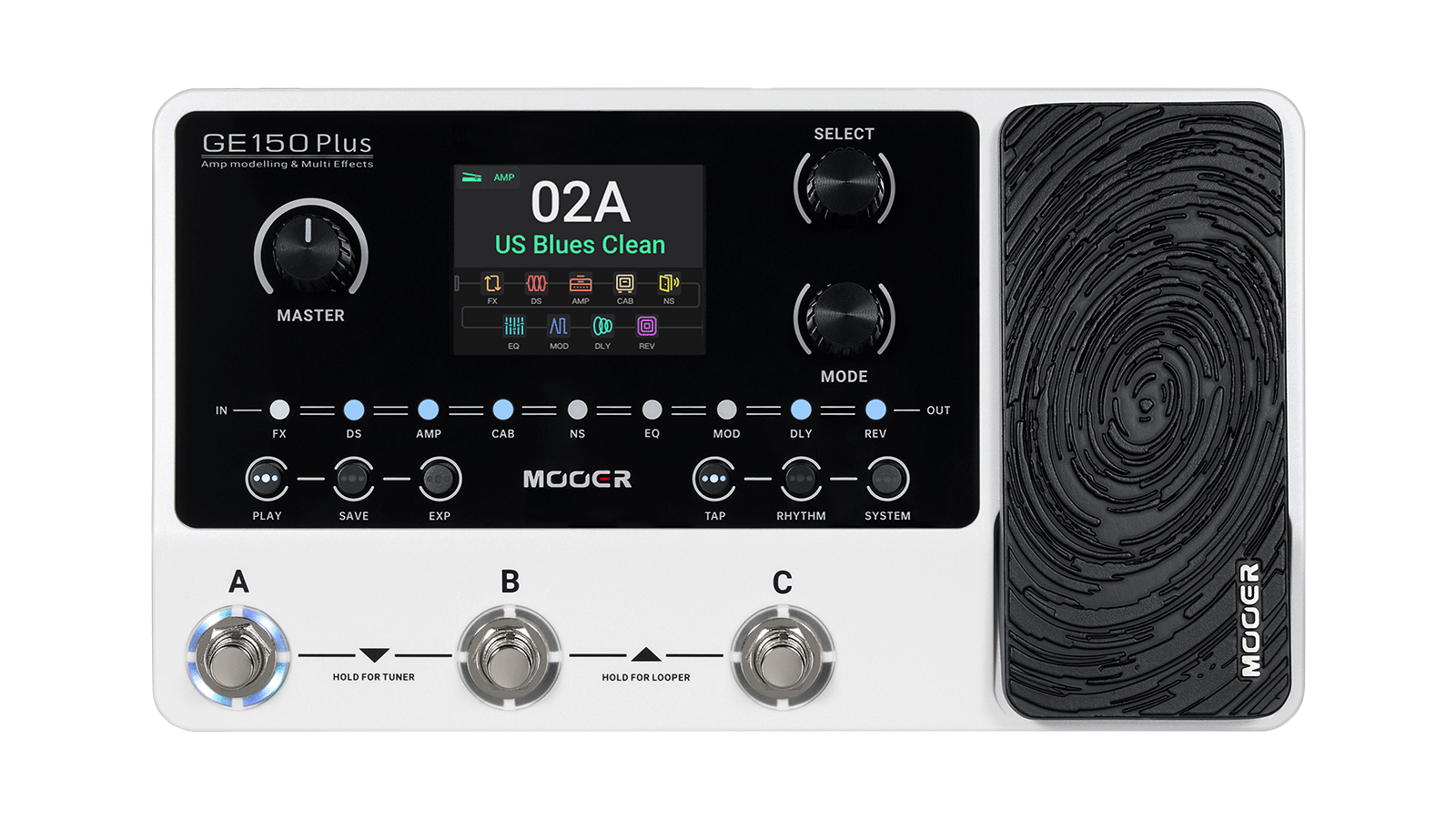
Following the success of the original GE150 pedal, MOOER is excited to introduce the new GE150 Plus, a new multi-effects and amp-modelling pedal. The device has been upgraded to offer guitarists advanced functionality, greater performance flexibility, and enhanced sonic quality through the new GE series design language and user interface.
First and foremost, the GE150 Plus provides memory for up to 198 preset patches, giving users a comprehensive range of tonal possibilities for various musical styles. Presets can be crafted through effects such as reverb, modulation, and dynamic enhancements, and most importantly, 55 precise preamp models developed using MOOER’s intelligent nonlinear sample technology. This enables the pedal to accurately reproduce the unique tonal characteristics and dynamic response of classic amplifiers, further enhanced by the device’s amplifier and cabinet modules. Both amps and cabs allow for loading MOOER’s MNRS sampling files, while the cabinet simulations also support third-party impulse response (IR), further expanding the device’s flexibility.
Another particularly impressive new feature of the GE150 Plus is the “spill-over” function, which enables delay and reverb effects to fade naturally when switching between presets–a feature that was missing from the original GE150. Ultimately, this ensures smooth, uninterrupted performance when making sonic changes during live performances.

As with past editions of the GE150, the pedal includes a convenient and intuitively designed 80-second stereo looper. This can be used in combination with the GE150 Plus’ groove station, which includes 40 integrated drum patterns alongside 10 metronome modes. All of these features are controlled effortlessly through three multi-purpose footswitches, bringing all manner of creative purposes for both live looping and rhythmic practice. An expression pedal is also built into the device, giving guitarists further dynamic control over parameters in their effects chain.
Compared to the original GE150, the GE150 Plus has USB connectivity that is significantly enhanced. Through USB-C, the pedal can be easily integrated with MOOER’s PC software for preset editing, as well as for data management, firmware updates, and mobile device audio recording through an OTG cable. An aux input port further expands practice possibilities by enabling external audio sources like smartphones, software, or other hardware to be used as a backing track.
Following MOOER’s recent trend of producing fully portable products for musicians on the move, the GE150 Plus is available in two distinct editions, one of which is battery-powered. The standard model offers reliable mains-powered operation, while the GE150 Plus Li version also incorporates an integrated lithium battery, providing approximately 9 hours of continuous use. Additionally, the GE150 Plus Li comes with an exclusive black finish. Overall, the GE150 Plus continues MOOER’s commitment to delivering powerful, versatile, and travel-friendly solutions, making it an essential upgrade within the critically acclaimed GE series.
Product Features
- Up to 198 preset patches
- 55 preamp models, made possible through intelligent nonlinear sample technology
- Amplifier and cabinet modules support MNRS sampling files
- Cabinet simulations support third-party IRs
- Three multi-purpose footswitches
- Parameter-mappable expression pedal
- “Spill-over” functionality for smooth transitions between effect tails
- Built-in 80-second stereo looper
- Integrated drum machine with 40 drum patterns and 10 metronome modes
- USB-C port for tone editing, recording, firmware updates, and mobile device connectivity (via OTG)
- Aux input port for external audio playback
- Compact, lightweight, and travel-friendly design
- Available in standard (white) and lithium battery-powered Li version (black)
Oh, No! My Amp Is Making Noise!
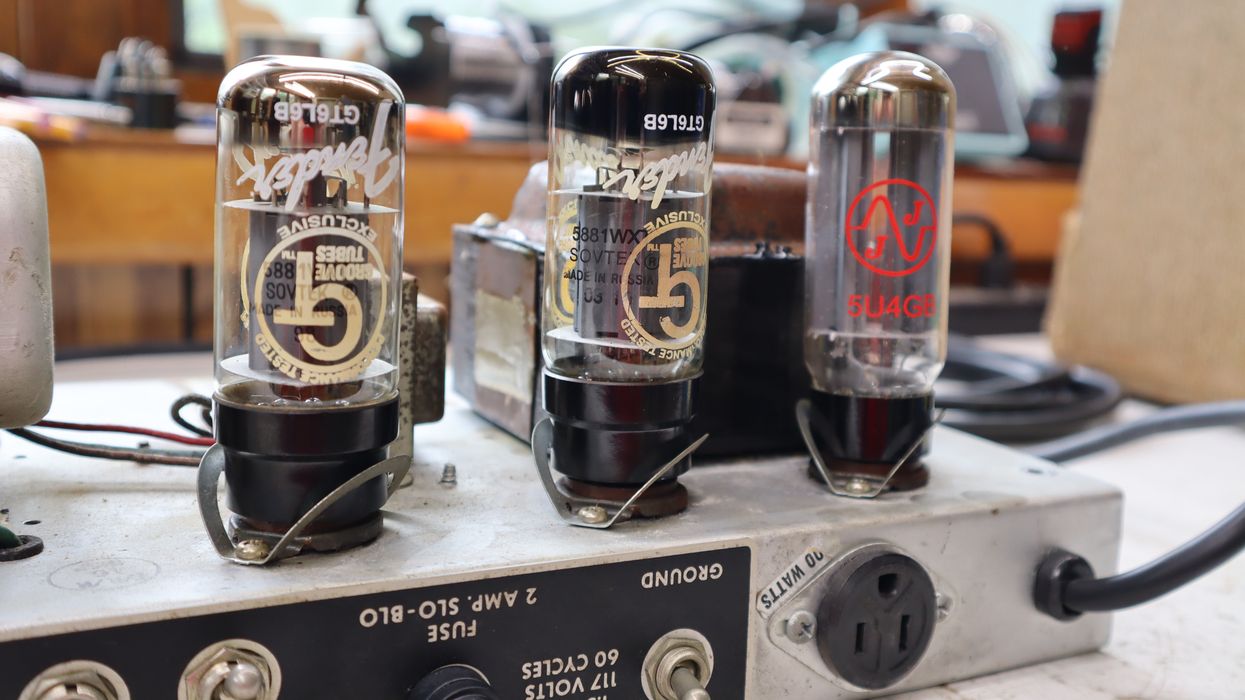
If you’ve owned a tube amp for pretty much any amount of time, you’ve been there: Your amp starts making noise—probably at the worst possible moment, whether onstage, in the studio, at rehearsal, or when you just really want to play—and you don’t know what to do. Maybe you keep it cool, but maybe you panic: Is my amp broken for good? Is this going to cost me hundreds of dollars? Fortunately, there are a few basic things you can check before you call your amp tech in a frenzy.
Ultimately, an all-tube guitar amp is actually a very durable device. But it’s important to remember that these amps need maintenance and have parts that are going to need to be replaced over the course of their lives—and tubes are the most likely place to check when you’re having a problem.
Many vacuum tubes are “military grade,” which means they can withstand shock, vibration, humidity, temperature, and many other harsh conditions. That doesn’t mean they are fail-proof, though. So, when your amp is making noise, here are some ways to check out your tubes.
Look
Do a visual inspection. Are your amp’s tubes bright and shiny, or do they look weathered and dirty? If they look old, they may be old. This doesn’t have to be a sign of something wrong, but tubes wear out like lightbulbs—they work until they don’t. I usually say power tubes have a two- to five-year lifespan (for professionals, it’s more like six months to two years). Preamp tubes have more like a five- to 20-year life. They can function longer but start to get problematic before they just die.
Look at what’s going on inside. Is the clear part of the glass still clear? If there is a smoky look on the inside of the glass, that is a sign of heavy wear. Look at the shiny mirror-looking part; that is the getter flashing. It should look bright, though sometimes there is a little fuzziness along the edges. If it is getting smoky, then the tube is tired. And if it has gone completely white, the tube is toast.
The last visual is best done in darkness. Look for the heater element inside. It is a wire in the very center of the tube structure that glows red when operating. Don’t worry about what shape it is, how much you can see it, or if it looks exactly like the other tubes. If it is glowing, it’s good; if it is dark in there, it’s toast.

Listen
Let’s move on to audible diagnostics. The amp works but is making extraneous noises. The first thing to do is unplug the guitar cable from the input of the amp, so nothing is plugged in, the amp is fully on, and the tone controls, volume, and master (if applicable) are full on. What noises do you hear? If it is silent with a tiny little bit of background noise, that is as good as a guitar amp gets.
Are you hearing an electronic, almost morse-code sound? A common modern problem is RF (radio frequency) noise from routers, cell phones, and transmission towers. It is not the amp and there is nothing to fix, but if you try moving the amp around the room or building, you may find a quieter place.
Is the amp making a constant “shhhhh” sound? Does it get louder if you turn the volume knob up? That is thermionic emission, the noise of electrons flowing. It is a byproduct of gain. Low-gain amps have less, and high-gain amps suffer greatly. Some tubes can add to this, so if you replace the first couple tubes in the signal path and it helps drop the noise floor, then keep the noisy ones for less critical positions.
Is the amp sitting there doing the snap-crackle-and-pop thing? This can be a tube issue, but most of the time it is a component issue inside. If you have a known good tube, you can replace the tubes one at a time, seeing if the noise changes. If you find that it was a tube, that tube is toast, so don’t use it as a spare.
Now, let’s talk about microphonics. Because of the amount of gain we have in guitar amps, microphonic tubes can be problematic. Start turning the amp volume/gain all the way up. If you get a howl, like with an open microphone, you have a microphonic tube. If it is still behaving but you can tap on the amp and get a sound like tapping on a microphone, that can be acceptable.
Finding the Cause
There are multiple tubes in an amp, so let’s find the root of the noise. The first thing is tap testing. The best tool is a pencil with an eraser. One by one, tap on the tubes with the amp on and turned up. If you get a significant microphonic sound from one, it should be swapped out with a quieter one. Now, this is the thing: A little bit of microphonics is normal, so it will take a little getting to know your amp to learn what is acceptable or not. Certain brands/models of tubes are better than others, so just because it’s new doesn’t mean it’s better or even good. As you go down the line of the signal chain, the gain is less, so you are looking for slight noises. Once you get to the power tubes, they can be microphonic, but they don’t howl like a preamp tube. They make a thud sound when tapped.
The other thing we’re looking for with this tap testing is rattling. Again, there is a certain level of acceptable rattle. But if you can hear it through the speaker, that’s unacceptable. If you have power tubes that rattle, this sometimes does not come through the speaker, but you can hear it when playing the amp at lower levels. If that bothers you, then they need to be replaced even though they’re functioning properly.
The last diagnostic is pulling the preamp tubes (not the power or rectifier tubes). Starting with the first tubes in the signal chain, pull them out one at a time and listen to see if the noise goes away. If you pull a tube and the noise disappears, then either that tube is the culprit, or your problem lies in that part of the circuit.
If you’re looking for a quick fix to get you through your gig or session and you narrow your problem down to a tube, go ahead and swap it out. If your amp is fixed bias, you may still need to head to your tech tomorrow and have it biased, but you’ll get your work done today. And when in doubt, replace your old tubes. If it turns out that wasn't the issue, you now have good spares for when a tube does eventually give you problems.



